 By Pepper Parr By Pepper Parr
BURLINGTON, ON July 11 , 2012 There was a way to save the Waterfront Advisory committee. The members of the committee just had to be true to themselves and remove their chair from office and then ask the General Manager to give them another year to clean up their act.
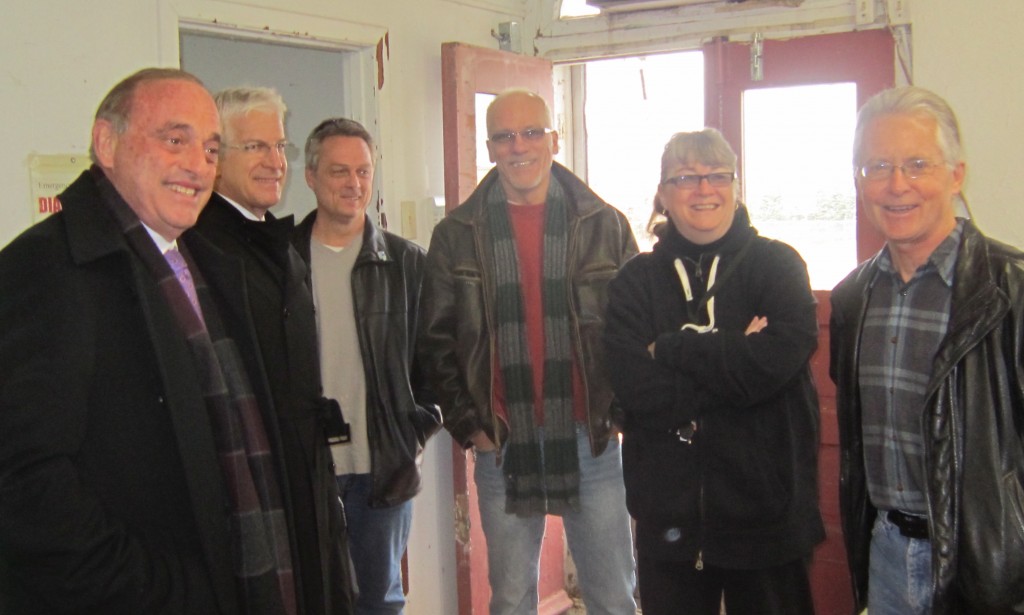 Without the leadership needed – this crew could go nowhere – the city lost the energy, knowledge and passion of some fine people. The city had reached its limit – they knew nothing was going to happen with this committee. It was sucking up all kinds of resources, holding meetings that achieved nothing and totally disillusioning its members. The frustration expressed by the members of the committee was painful to listen to – but as a group they weren’t able to summon the personal courage or the courage of their convictions to remove Nicholas Leblovic as chair.
They were not only afraid to remove him as chair – they actually re-elected him as chair at a time when there wasn’t a natural leader available.
But then Bob Wingfield was appointed to the committee and that was the opportunity for the members to take a brave, bold move and give the important committee the life and leadership it needed.
How? Here’s how.
A member raises his hand at a meeting and declares he has a motion he wishes to put forward. The chair has to recognize the member.
The motion is: To declare the chair of the Waterfront Access and Protection Advisory Committee vacant.
There will be a look of stunned disbelief on the face of the chair.
Within seconds another member raises his hand and says: “I second the motion”.
Seconds after that a third member asks the chair to call the vote.
And they vote on the motion (the vast majority would vote to remove this chair) and the chair is then vacant and the members can proceed to elect a new chair and get on with the business they were asked to do on behalf of the city.
Messy – sure it is – but not nearly as messy as this really important committee with some intelligent, dedicated Burlingtonians on it who were and are passionate about what we do with our waterfront.
That opportunity is basically lost – unless, at the Advisory committees next meeting, which was scheduled for Friday, the 13th, the committee does something along these lines and then appears at the city council meeting on the 16th and asks the council to defer the vote to sunset the committee on December 31st, 2012 and allow them to come back with an agenda and a work plan that sets out how they will get some much needed work done.
Will the members of the Advisory committee do this and save an important committee – they can’t – the meeting planned for July 13 was cancelled – they will not meet again until September.

 By Pepper Parr By Pepper Parr
BURLINGTON, ON July 10, 2012 It could have been different, for the sake of Burlington it should have been different, but when the Budget and Corporate Services committee report on Tuesday set out the recommendation that the Waterfront Access and Protection Advisory committee be sunset December 31, 2012, the city lost eyes, opinions and advice that is badly needed.
The problem was that the Advisory committee didn’t give very much in the way of advice or direction but instead got stuck in endless meetings during which they were briefed by expert after expert. It was a little like a university course, interesting and instructive but not the purpose or mandate of the committee.
There are some fine people on that committee – they were just poorly led.
The recommendation to the Council committee was brief and brutal – one thirteen word sentence. Kill it, and other than Councillor Marianne Meed Ward, no one really came to its defense.
Chair Nicholas Leblovic spoke to the Council committee and said he felt he had been “blind-sided” by the recommendation, which is a bit of a stretch. He had been told numerous times by people who knew this committee was in trouble. As chair he didn’t have the capacity to lead nor did he appear to have the capacity to listen.
Despite the chair, the committee did some very good work and some of that work does need follow up. The Windows on the Lake problem has to be resolved and without a committee to press the matter – not much will get done. Rob Peachy, Manager of Parks and Open Spaces for the city told the committee that “this was not one of their favourite files”. Having to go up against influential landowners along the Lakeshore who don’t want people wandering about close to their property is not an easy task.
At one point the city gave a resident a lease on a strip of land leading to the edge of the lake for 50 years at $2 a year. That is called a deal.
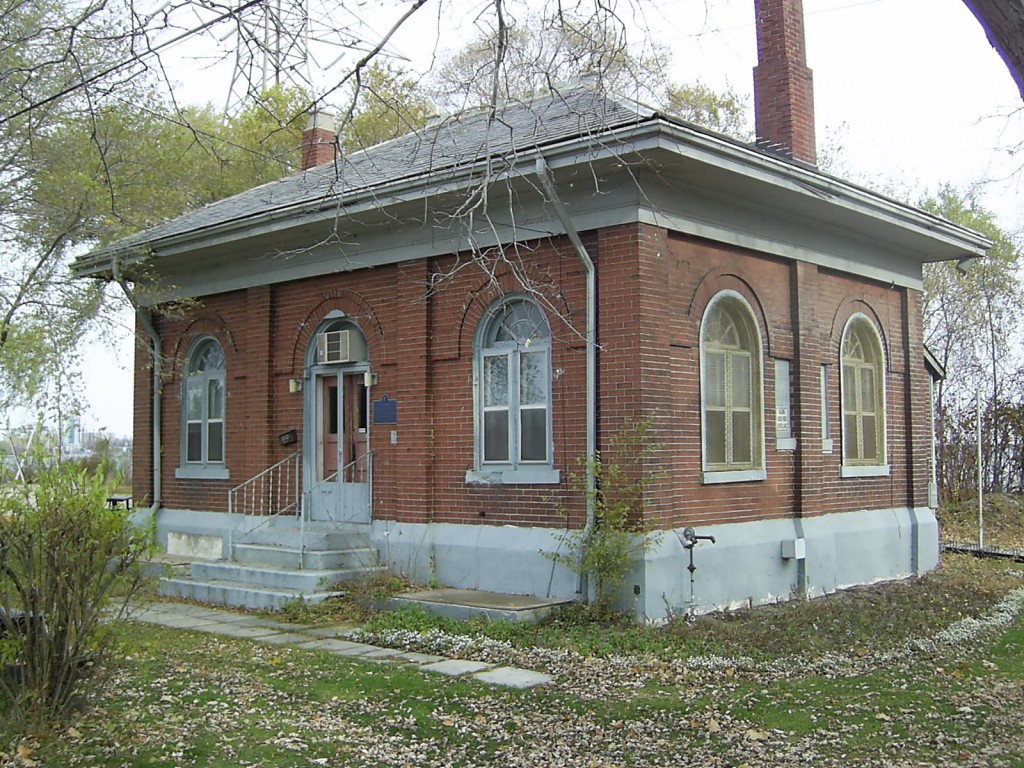 One of the ideas the Waterfront Advisory people had that actually got out of the committee and to Council was to turn the Pump House into a coffee shop. Councillor Dennison wouldn’t hear of it – he wanted an upscale wine bar where he could watch the sun set. He did vote to sunset the committee. The committee managed to get a resolution through that asked the city to look into making the Pump House more than an empty storage space and look for ways to turn it into an upscale coffee shop. When the recommendation got to Council Committee, Councillor Jack Dennison would have none of that – he wanted a place where he could sit on a deck with a glass of wine in his hand and enjoy the setting sun.
Council was eager for advice, directions and ideas from this committee – there were just so few, and not because the members had nothing to say – they just couldn’t get much past the hands of the chair who seemed unable to let his members do what they were very capable of doing.
Leblovic did pull of one significant event and that was getting former Toronto ,Mayor David Crombie to speak to the committee. Crombie was energetic and had all kinds of ideas for the committee. Crombie urged them to be proactive and to hold a design competition that would bring forward ideas and get something happening. But that was about as far as it got – except for the work that Gary Scobie and Sarah Banks did with that idea.
A city council committee kind of liked the idea when Scobie took it to them. They didn’t buy his first cut of an idea – and asked him to work on it more and bring it back. Unfortunately, Sarah Banks, the intellectual and emotionally driven leader behind the idea moved from Burlington, a city she was never particularly comfortable in.
Banks didn’t have the best of working relationships with Leblovic and really didn’t get the support she needed. She was one of those people who just wanted to get things done and not just spin her wheels.
City General Manager Community Services, Scott Stewart, spent far too many hours at the committee table gnashing his teeth and told council committee that he voted with his feet and just stopped attending the meetings.
In her passionate plea to not sunset the Waterfront committee Councillor Meed Ward pointed out that there were some structural problems with the committee but they could be fixed. The demands on city hall staff could be reduced. She made no comment about the leadership of the committee.
This was a Committee that had three Council members on it; the Mayor, who attended frequently along with Councillors Meed Ward and Craven. There is no other Advisory committee in the city that has as much Council representation.
Where does the city go now for advice on the waterfront ? The Mayor thinks he might just `grab a bunch of people and look to them for input” – so much for city wide representation.
The city report suggested there was considerable overlap between the Waterfront Advisory and the several other Advisory committees in place; they didn’t think that when the committee was created.
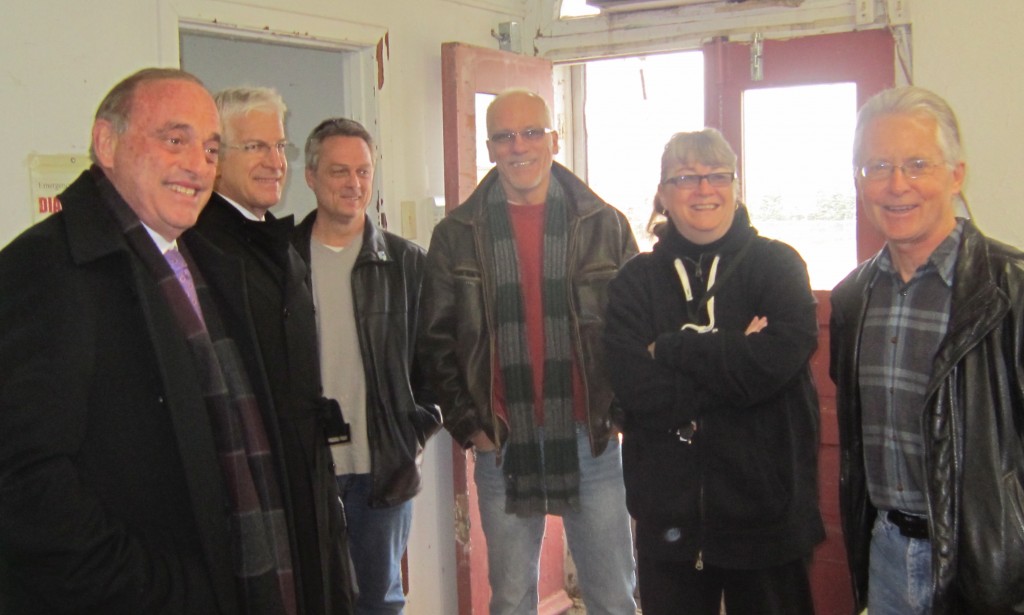 Members of the Waterfront Advisory Committee tour the Pump House on the Beachway. One of the really solid recommendation that made it out of the committee to city council was to turn the Pump House into a coffee shop – wine bar. The Committee won’t exist to see that happen. Nicholas Leblovic is on the left. Waterfront Advisory was created by former Mayor Cam Jackson, who at the time saw the issue of the pier and the whole waterfront mess as having the potential to substantially impact his re-election campaign. The Committee was set up to counter some of the clout that Save Our Waterfront (SOW) was having. They had 2000 members across the city, they were active and they were focused And they had some money in the bank. The committee served as part of Marianne Meed Ward’s election apparatus. It was never official, but there was little doubt in the minds of many that SOW and Meed Ward were joined at the hip.
And there was very little doubt that Nicholas Leblovic and Mayor Jackson were joined at the hip as well when Leblovic was appointed to the committee and quickly became its chair.
The Pier turned out not to be quite the issue many thought it would be during the municipal election and it turned out not to appear on the Waterfront Advisory Committee agenda as well.
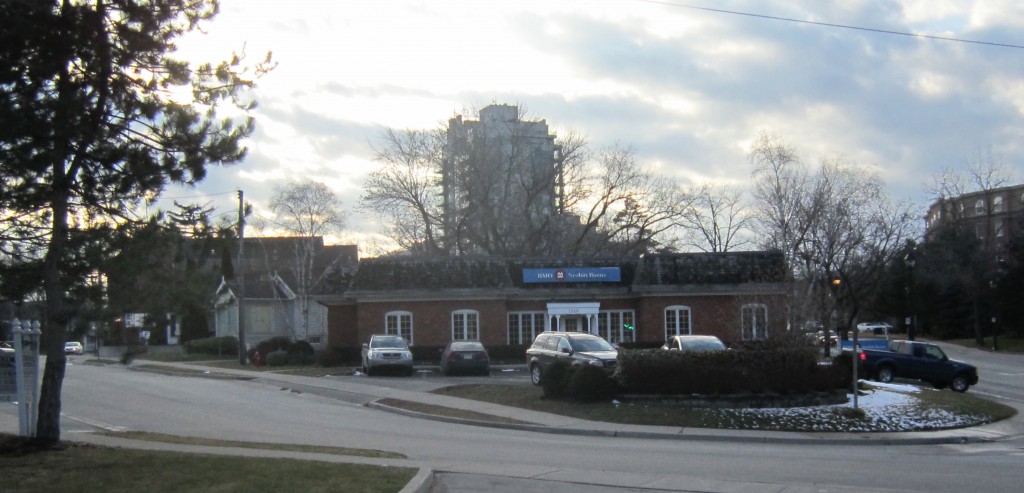 It was called the “football” because of its shape. This view, from the east end looking west, is land privately owned. There are more than a dozen property owners in the “football” with none of the land owned by the city. Getting the property owners to work together to develop a waterfront that will compliment Spencer Smith Park and lessen the massive impact the eventual 22 story tower to be built to the immediate west of the football requires the kind of leadership the city has yet to see. The Waterfront Advisory did some excellent research but wasn’t able to land the idea – or the opportunity. What was called the Waterfront Precinct drew most of the time and attention of the committee. They believed that citizens should have some say in what happens to private lands in such a sensitive part of the city but try as they did – they were never able to get any traction with the major players. They did do a lot of solid ground work and they helped the city fully understand who the players were in the game on what came to be called – the football, that oblong piece of land between Old Lakeshore Road, Lakeshore Road from Pearl on the west to where the two Lakeshores merge on the west. But they were not able to create any consensus on what was really a political issue.
There had to be some major “bully pulpit” leadership from city hall that would leverage what the Waterfront Advisory people were doing and what was coming from city hall – that didn’t happen. Mayor Goldring never really had much in the way of a working relationship with Leblovic who probably saw him as a Cam Jackson holdout.
David Crombie had the right idea – he just wasn’t able to effectively infect Mayor Goldring with the kind of grit it takes to lead this kind of community building.
The Waterfront Advisory should have had a major impact on the input side of the Official Plan Review. People in the Planning department, and elsewhere in city hall, realized the Advisory committee was never going to get anything done and various people on the Waterfront committee managed to slickly slide the issue out of Waterfront over to Official Plan Review. The report that recommended sun setting the committee put it rather well when it said: With the issue of the Old Lakeshore Road re-development now being addressed through the Official Plan process, the current work plan of the committee is substantially complete.”
They took Leblovic’s lunch off his plate while he had his knife and fork in his hand – he missed that play completely.
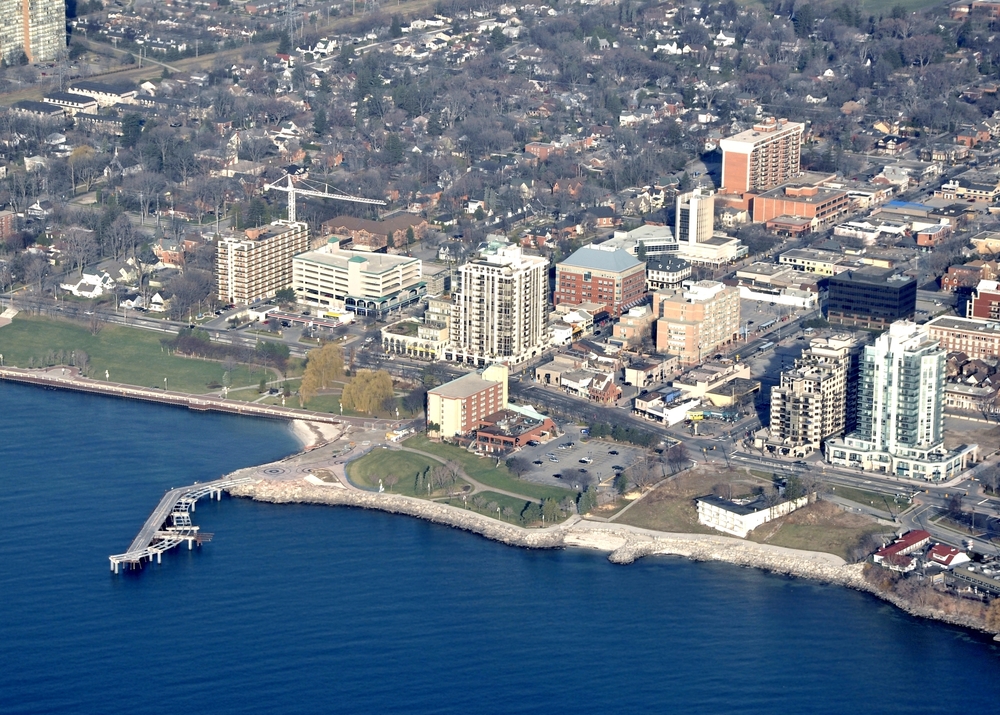 West of the Pier, the waterfront is nicely developed and if we do it right the Beachway should make the lake frontage from the park to the canal a great place to be. The task, that the Waterfront Advisory wasn’t able to do is come up with advice the city could use to develop east of the pier. That is still a challenge waiting for some leadership. What now for the Waterfront? Does SOW have to come back to life and lead that agenda. That wouldn’t be a bad idea. During the Council committee meeting it was suggested that perhaps BurlingtonGreen could take on the task or perhaps the Sustainability Advisory people; the Mayor has an excellent working relationship with that group.
Right now however, one of the two most vital elements in the city’s identity are either adrift or under threat. The continued chatter at the provincial level about a road through Mt. Nemo and the Niagara Escarpment and no real community led leadership on waterfront development, our anchors are laying underneath the water unattached to any chains.
This is not a healthy place to be.

 By Pepper Parr By Pepper Parr
BURLINGTON, ON July 11, 2012 The first harvest is ready!!! The jars have been readied, the tags are printed and the product is now on sale. There will be between 60 and 70 lbs. available. It will be on sale at the new farmer’s market held every Friday from 11 – 2 on John Street just north of James Street back in behind Centro Gardens.
Of course there is more than just natural honey on sale but let’s let Russell Gibbs tell the story about the honey; it’s quite a tale.
 Russell Gibbs – a beekeeper and a graphic designer – with a sweet tooth. “This harvest is the first bloom of the 2012 season, our bees forage on a variety of plants and this early summer harvest is full-bodied and rich – some of the best honey I’ve had in a while if I do say so myself. It’s a true Southern Ontario wildflower honey. It’s also packaged quite beautifully
 The real thing – from the hive to you in a re-usable Mason jar. Honey is available now through the beekeeper (me) for $10 per 500 g jar. We have 60 jars and this will be available until it’s sold out. There will also be a late summer harvest which will be available in September 2012.
A couple of notes about our honey;
– Our honey is as “straight from the hive” as it gets. We extract the frames, filter, then bottle it.
– All real honey will crystallize over time, if that happens just place the jar in warm water (without the lid) until it softens up – don’t boil or put it in the microwave.
– Our honey is more expensive than others, why? For starters its not mass produced. We’re a small batch/small operation and not only are we focused on the quality of the product we also believe in quality packaging.”
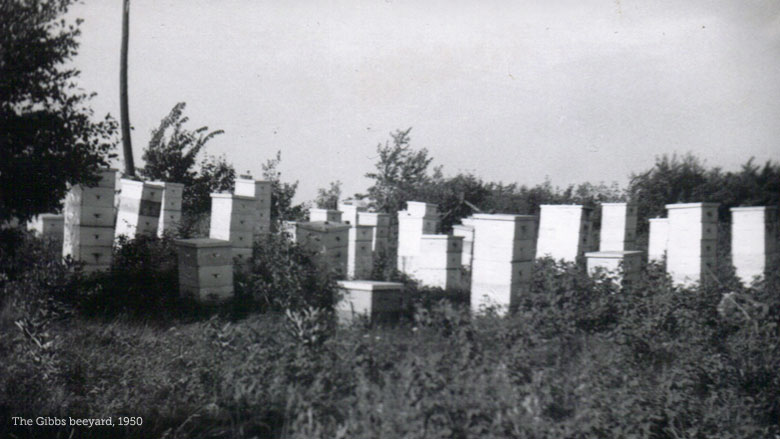 Russell Gibbs comes from a long line of bee keepers. The family “beeyard” around 1950. Gibbs Honey has been around since the 40′s, maybe even before the 40′s? in various iterations and incarnations. The first beekeeper in my family was my great grandfather Albert Gibbs. He kept a couple of colonies on the farm, which is what most farmers did back then. When my grandfather Michael took over the farm he decided to expand the operation and sell honey. He kept close to 100 hives, that number went up and down throughout his career as a hobbyist beekeeper. My uncles eventually took it over from him and grew it into a commercial operation, they own and operate Gibbs Honey in Dalkeith, Ontario on the family farm. My cousin Jason is researching Sweat bees with Cornell University, last year he discovered 19 new species.
Gibbs Honey in Dundas, Ontario is operated by Russell Gibbs, a 4th generation beekeeper and graphic designer. Russell got into beekeeping, while searching for a deeper connection to his family history and nature. It all started when his Dad gave him his old beekeeping veil and a copy of “The Hive and the Honey Bee” by L.L. Langstroth. After reading lots of other books, taking courses and finding a beekeeping mentor he decided to go out on his own. Russell kept two hives in 2011 and is expanding to 8 for the 2012 season.

 By Pepper Parr By Pepper Parr
BURLINGTON, ON July 9, 2012 The City of Burlington has announced that Joan Ford, long-time city employee and acting executive director of the finance department, has been named director of finance effective July 9.
Ford’s home position was deputy treasurer with the city. She has served as acting executive director of finance since July 2010, after one year as acting director of finance from April 2009 to April 2010.
“Joan has been doing an excellent job in the acting role as head of the finance department,” said Kim Phillips, general manager of corporate services. “I look forward to continuing to work with Joan as she continues to lead a top-notch finance team at the city.”
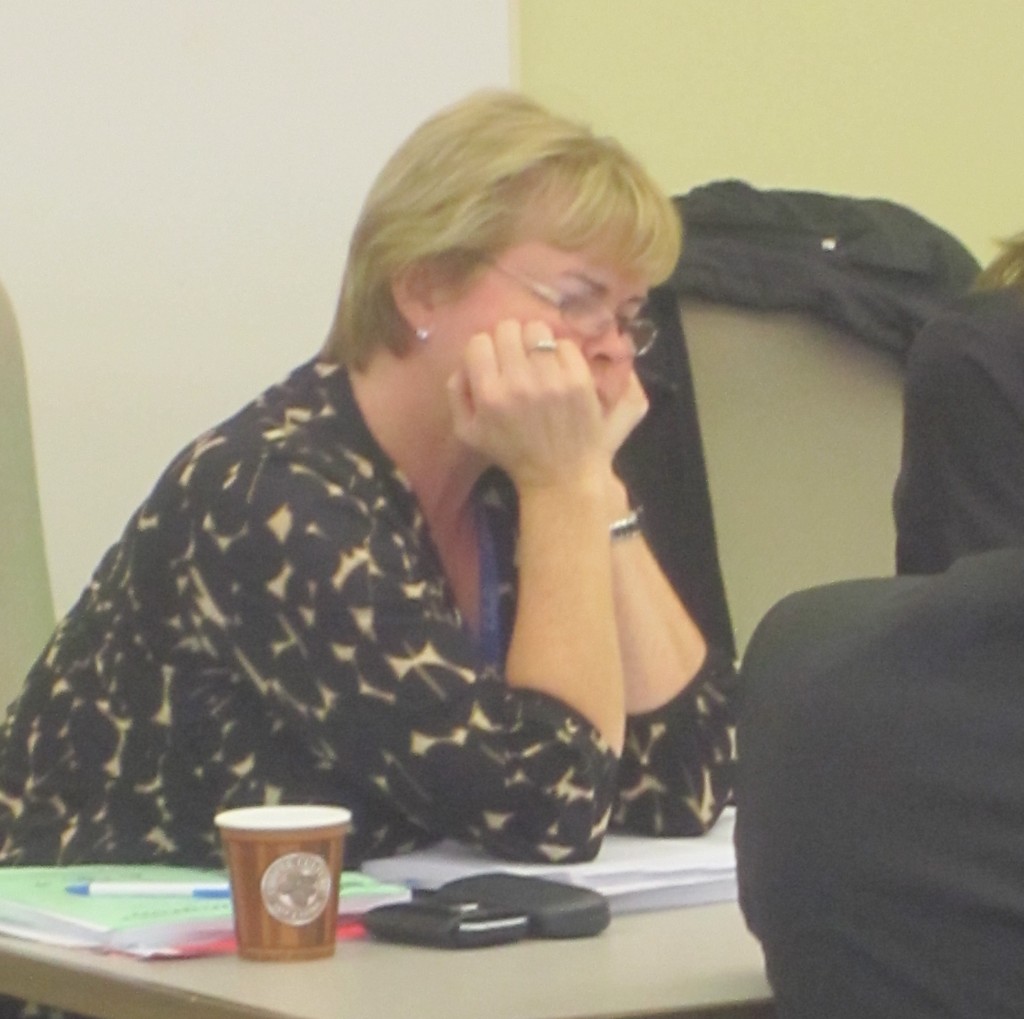 Joan Ford, Director of Finance – Finally! Ford, who has been with the city since 1988, has an Honours BA in Economics from the University of Waterloo and is completing her CMA designation through the CMA Executive Program with the Certified Management Accountants of Ontario. She has progressed through a number of finance roles at the City of Burlington, including:
Financial analyst
Senior financial analyst
Supervisor of financial policy
Manager of revenue and taxation
Manager of financial planning and taxation
Deputy Treasurer
“I am pleased to continue in this leadership role,” Ford said. “Finance has a skilled and professional staff team in place that is committed to serving the needs of City Council and the people of Burlington.”
The city recently restructured its three divisions to balance workload, develop synergies within divisions and increase corporate capacity to best reflect the needs of the community. Kim Phillips and Scott Stewart are two of the three general managers. Recruitment for a third general manager will take place this fall.
Now that you’ve read all the bafflegab – know that Joan Ford did all the hard work that had to be done to get where she is. Getting her Certified Management Accountant (CMA) designation was not easy – she had a household to manage and a budget process that was at times close to a killer.
Ask her for a budget number – and zap – she had it at her fingertips. Look for a new innovative way to get data into the hands of department heads who had their own budgets to manage and at the same time put numbers in the hands of council members – and both Joan and her staff come up with good ideas.
While not only doing the job that we really didn’t pay her for doing – she developed one of the smartest departments in the city. Some of the people in her department have moved on to other departments where a tougher, more accountable approach to the numbers will begin to be felt.
Congratulations Joan – you earned this one.
Now take a well-earned vacation and have the CMA certificate framed and on your office wall.

 By Pepper Parr By Pepper Parr
BURLINGTON, ON July 9, 2012 Her name is Alice and she is close to being the “breadwinner”, along with a herd of goats, for Featherstone Family Farm on Guelph Line just past the heart of Lowville. Alice shares the 25+ acre property with a herd of goats, all kinds of foul – chickens, ducks – a whopper of a sow and piglets galore.
 Ruby – mother to dozens of piglets, lays in a cool spot away from the sucklings. That plus three children who scamper about with next to no clothing – they are of an age where you can do that. All is carefully watched over by Michelle Macdonald while her husband works the tractor mucking out the barn.
 Chris the boarder, with Alice and Daisy the dog. The two brown beef cows are being grass fed for fall. Chris, the boarder who lives in a trailer, rounds out the picture of the family at Featherstone Farm who are part of Halton’s rural community that includes not only the tony equestrian set but small market farmers who choose to live a different life style.
The first week of the Farmer’s Market, held every Friday between 11 and 2 in the John Street parking lot behind Centro Garden, went well. The offerings were small but the atmosphere and the family feeling was worth the effort and the time.
The farmer’s market is still working through it’s identity – it is a part of something known as Plan B, which is exactly what you would expect – the plan behind the first plan you had. Except these people are focused on healthy eating and getting produce from local farms onto local kitchen tables.
Lettuce from California doesn’t make a lot of sense to the Plan B people. Trucking food across a continent isn’t really sustainable from their point of view. Focusing on local and knowing a bit more about the people who provide your food is the direction they favour and anyone who sees the worlds the way the Plan B people do – might want to mosey along.
Barry Imber, a graphics designer by profession, has a thing about eating well and eating local produce, decided Burlington needed something downtown that was organic on its focus and he sort of made it happen. The first week went well; the second Friday was blisteringly hot and it too went well.
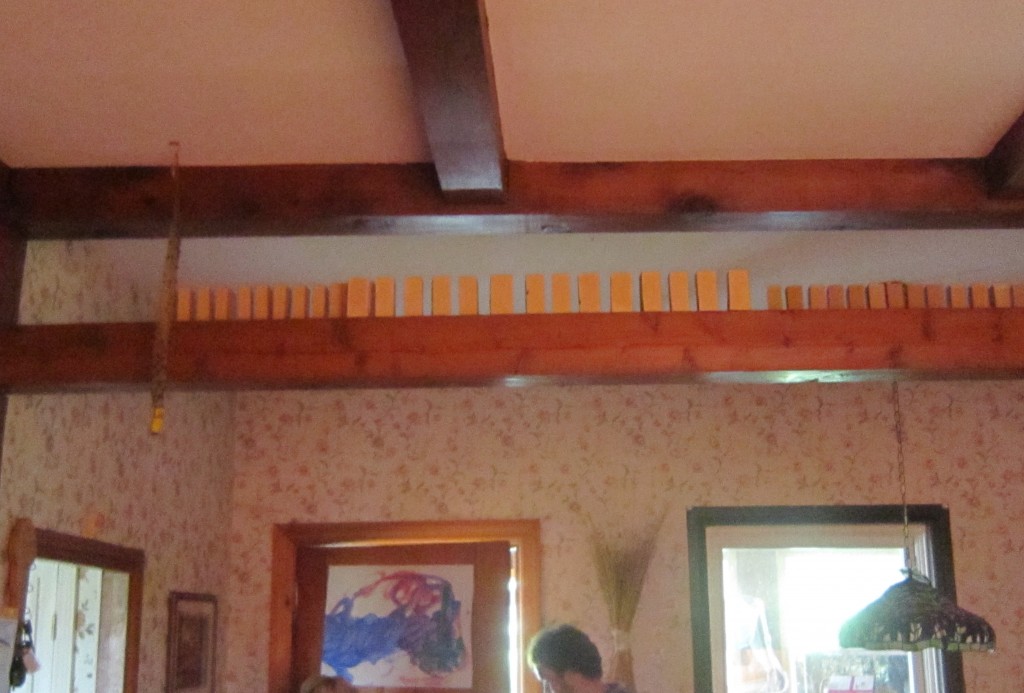 Soap being readied for sale sits on a beam in the kitchen – “best place to cure it” says Michelle Macdonald, farm operator The third Friday will see some additions to the offerings. Michelle Macdonald will be bringing some hand made soap that is now ready for sale. Made on her farm with pork lard, goat milk, lye and pure essential oils. Some with lavender sprinkled into the soap square. They are currently in her house sitting up on beams where it is getting ready for sale.
The Macdonald farm sells eggs from the farm gate – there is never enough to go around. They sell bacon and other pork products. They use the milk from their herd of goats for other products they produce. They are raising two beef cattle that will be ready for market later in the year.
The third week will see some growth in terms of the products offered and, if a Burlington resident chef who is well known and respected in the area for their passion for local natural foods and gastronomy, does not see the birth of a child they are expecting , they will be on site filling in the gaps with beef and game this week and eventually cheeses and other related products.
This chef – you have to be there Friday to learn who it is, will be drawing from his extensive list of natural food producers and farmer relationships will be doing some sample cooking and demonstrations from time to time.
Imber explains the situation thusly: “The tentative thing here is that he is about to have a baby any minute so there is a chance he just can’t make it. I’ve insisted that the market not be a thought in his mind if it’s at all challenging to juggle a new baby, husband responsibilities and frozen meat.” That “frozen meat” is a clue I think to whom the chef is.
In the event that the baby arrives –the chef will be at the market on the 20th.
Featherstone was one of the mainstays at the first session of Burlington’s Friday Market that is held on John Street right behind the lush Centro Garden.
The Burlington initiative may get some coverage in Pure Green Magazine from Huntsville. They will be joining the crowd at the market on the 20th.
So – the Plan B farmer’s market is taking on a life and style of its own. Imber is working on a bakery source to add to the offerings.

 By Pepper Parr By Pepper Parr
BURLINGTON, ON July 8, 2010 A city council committee will consider a contribution agreement confirming how and when the city will contribute $60 million toward the redevelopment of Joseph Brant Memorial Hospital, subject to the conditions within the agreement.
The city agreed in principle to put up half of the $120 million the province required the community to contribute to the redevelopment of a hospital built in 1961. The last major update and refurbishment was more than 40 years ago.
Problems cropped up when the hospital suggested the city pay for the building of the parking garage that was needed early in the redevelopment. Cars had to be given a place to park so that space could be used to dig a hole in the ground and begin the actual construction the hospital hopes to see started before the end of the year.
City council has possession of this file – which means reports and site plans go to a council committee where they get debated and discussed.. The usual practice for Council is to delegate this to the Director of Planning.
The City approved a contribution of up to $60 million in December 2009 , with the intention of preparing a contribution agreement between the city and the hospital. The go-forward strategy, approved by City Council in April 2012, called for the city to negotiate a contribution agreement that provides for the “responsible and timely release of funds.” Four negotiation meetings were held between the negotiating teams for the city and the hospital in May and June 2012.
These were very contentious meetings and while everyone has kissed and made up the city at the time insisted on knowing what was going to be done with the money they drew from taxpayers.
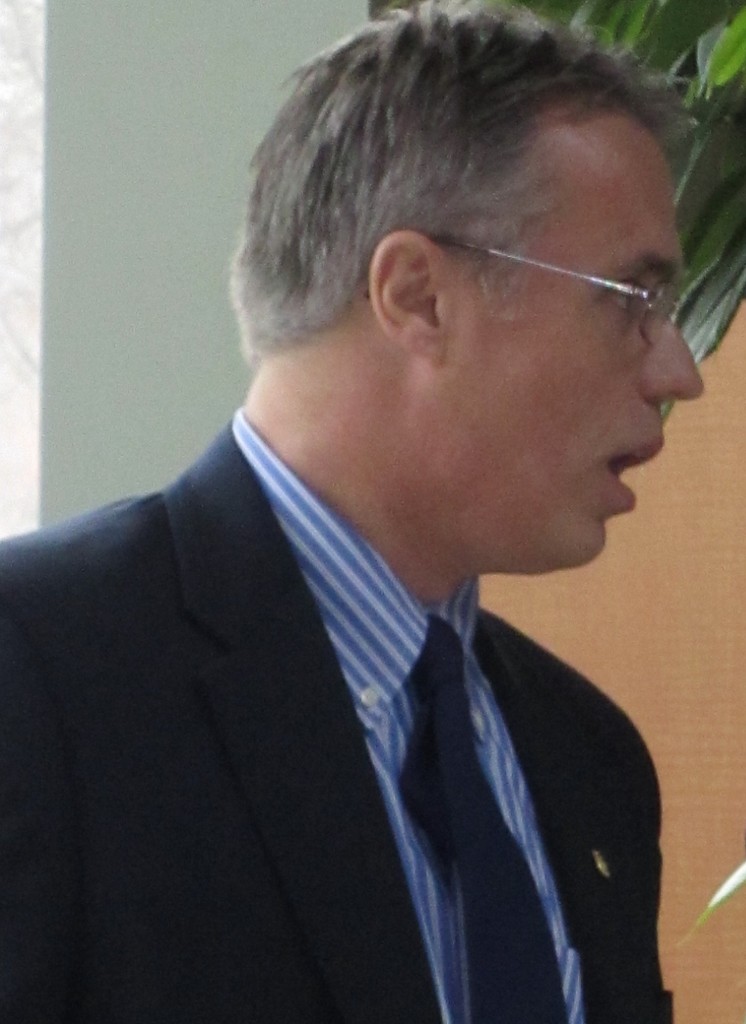 Mayor does the usual political speak and tells taxpayers the agreement with the hospital represents a milestone – he could have said it represents a “millstone” to the taxpayers and been just as correct. In typical political bafflegab Mayor Goldring said: “This agreement is an important milestone in the much-needed redevelopment of Joseph Brant Memorial Hospital. We want to ensure that we have the best agreement possible for taxpayers while ensuring high quality health care for years to come.”
Assuming the contribution agreement is approved by City Council on July 16, the city’s contribution will go toward the purchase of equipment for the second phase of the hospital’s redevelopment, which includes construction of about 288,000 square feet (21,182 square metres) of new hospital space, including a new six-storey south tower; construction of a new power plant; and the renovation of about 116,000 square feet (10,777 square metres) within the existing hospital building.
Construction of the hospital is planned to begin in December 2014 and will take about three years to complete. Before that construction can get underway the hospital has to clear some land and build a structure that will include a parking garage. This first phase is scheduled to begin in early 2013 and finish in early 2014. It will include construction of the parking garage and administrative space that will house the Halton McMaster Family Health Centre. City funds are not contributing to the first phase of the redevelopment.
In a prepared statement city general manager Scott Stewart, General Manager of Community Services said: “On behalf of the staff negotiating team, I am pleased to bring forward what we believe is a responsible draft contribution agreement for council to consider.” He might have added that there was a lot of arm twisting and muttering under their breath to get to this point. Stewart deserves credit for landing this one; the hospital administration did not make it easy.
 The construction of the additions to the hospital will orient everything towards the lake and result in significant changes to the traffic flow and to the way people see Lakeshore Road and the Beachway community. By the end of 2012, the city will have a total of $8.4 million in the bank collecting interest. A total of $4.8 million came from a special tax levy. City Council also earmarked $3.6 million from previous years’ surpluses in 2009 through 2011. The 2012 tax levy amounted to $7.49 for each $100,000 of residential assessment.
City Manager Jeff Fielding said at a council meeting that a $60 million undertaking will be the biggest Burlington has ever done and it represents a significant long term expense for the taxpayers.
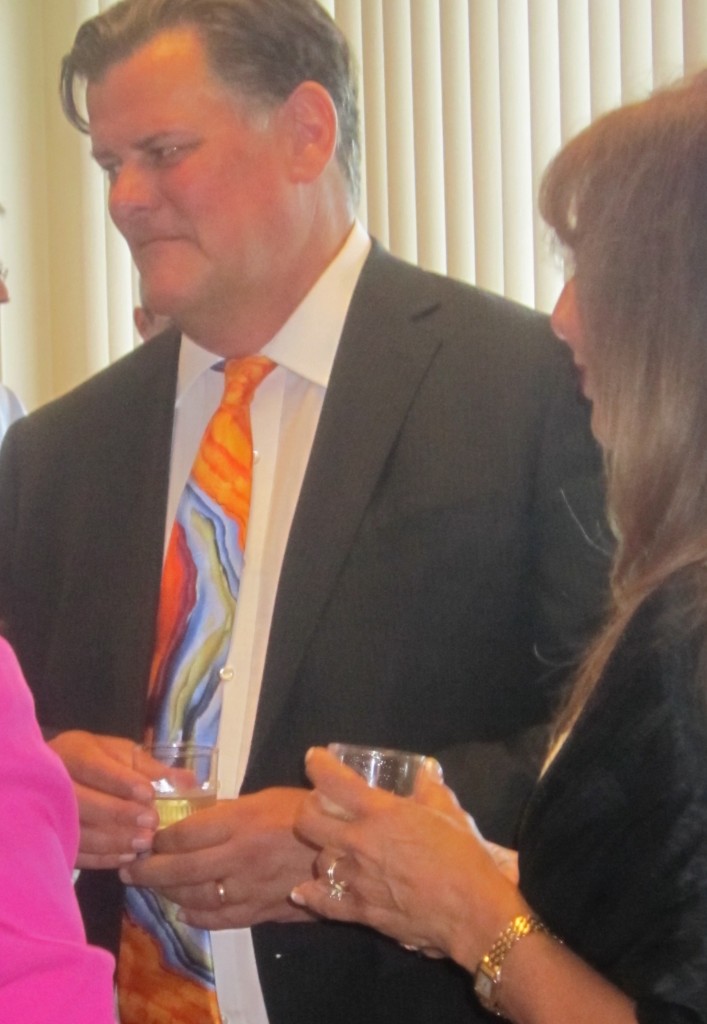 Stephen Friday, JBMH chair will bring a different style to the role he now plays. He has a strong working relationship with the Mayor which will help. He also has the smartest collection of ties in the city. Up until very recently hospitals were a provincial responsibility – that changed when the province looked to the municipalities for a portion of the funding where new, significant developments were being done. If the municipality is at the table financially one would hope it would have more input on the operation of the hospital – which would result on a significant change in the way the city and the hospital administration work together.
There is now a new chair at the hospital. Susan Busby who spent more than 15 years with first the hospital foundation and then the hospital board took a well-earned retirement. She has been replaced by Stephen Friday who brings a significantly different operating style to what he does and has a background that included working with very senior managers and was a major force in one of the larger asset management firms in Ontario.
There are opportunities now for both the Mayor of the city and Stephen Friday, the new hospital chair to fashion a different working relationship that will reflect the changing times.

 By Pepper Parr By Pepper Parr
BURLINGTON, ON July 5, 2012 For Gary Carr, chair of the Region of Halton the real problem seemed to be that when a Minister of the provincial government gets shuffled off to another department – they take all the promises they made with them. It just isn’t the way a government can be run according to Carr, who has been in the government game for a long time. He served as an MPP from 1990 to 2003 and Speaker of the Legislature from 1999 to 2003. He’s been there and he has seen it all and right now – he doesn’t like what he is seeing.
The concern is Burlington’s Escarpment which is the rural part of the city. The province has a growth policy which if met is going to require new roads to handle all the increased traffic.
The bureaucrats get told to do a study, which in this case is a full, detailed Environmental Assessment – which means they look at everything. The bureaucrats don’t create policy – they just do the research and come forward with recommendations. What is scaring the daylights out of Burlington is that those recommendations tend to become the only choice and Burlington has learned, from painful past experience, to get your two cents worth in while the thinking is being done.
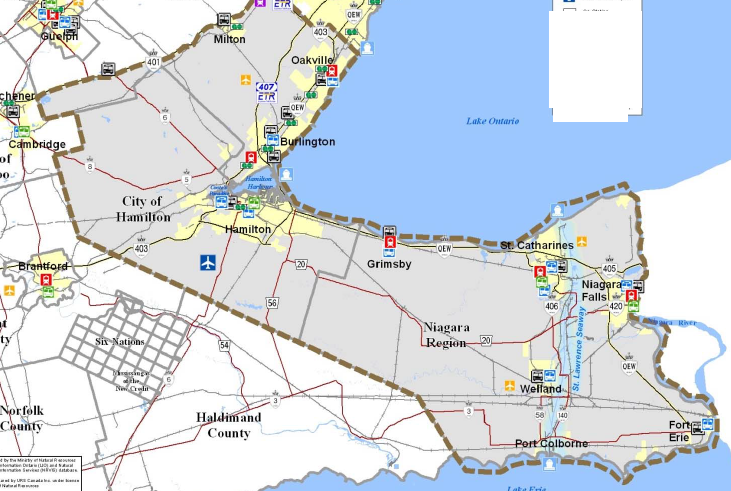 This is the part of the province provincial bureaucrats are studying as they look for ways to create more capacity for road traffic. Their studies indicate that one of the ways to meet the demand for additional road capacity is to run a corridor through the Escarpment. Other groups feel this isn’t necessary and the Regional government thinks it is totally wrong. Chairman Carr had some difficulty understanding how very significant decisions made at the Regional level, communicated to the government and be known to the bureaucrats doing the research, but have no impact on that research – other than be “documented”. Carr was close to aghast when he learned that the bureaucrats knew about the Region’s concerns which did not result in any comments to the study team from the Ministry. “Did it not occur to you to ask questions?”
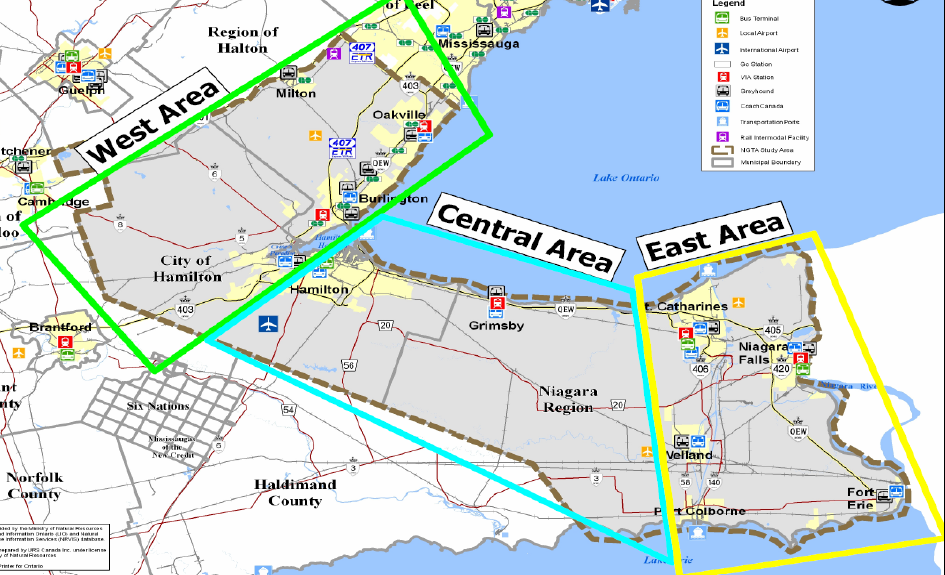 The Region and the city of Burlington are focused on the west area. And they don’t like the look of some of the plans that are being talked about. The Regional people apparently don’t believe that the documented concerns were to have all that much impact. Carr believes that the 22-0 regional council vote against any road through the Escarpment – a shut out as Carr put it – has to have an impact and not just be “documented”.
Mayor Goldring wanted to know if there was a matrix used to arrive at a decision. There was: it involved transportation performance, the environment, the economy and communities. Behind those four main points were a host of factors that impacted the recommendation the bureaucrats would make.
The nagging suspicion at the Region was that the EA recommendation would become a decision and Burlington would have a new road north of the current Dundas/Hwy 407 which would then be the new build to line – and with that, what the city has as a rural element would be gone.
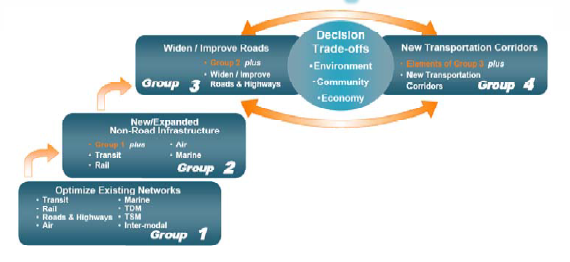 The bureaucrats have developed a building block approach and are looking at all the existing options. Group ! is made up of places where they think they can optimize the existing capacity. If that doesn’t provide what they feel is needed to move up to Group 2 and consider new expanded NON road infrastructure. If they can’t get the capacity they maintain they need the they move into groups 3 and 4 where they look at widening and improving existing roads and look at new transportation corridor. All the bureaucrats do, explained John Slobodzian, is collect information and, as he put it “we document”. The inference was that with all the documentation they are able to make recommendations that get passed along to the Ministry. Fine – but is there anyone within the Ministry who would know the file well enough to seriously review and weigh the recommendations made?
It’s sort of like a trial – where there is no defense offered nor is there an opportunity to put forward a defense. The prosecution, in this case a group of well-intentioned bureaucrats who have no skin in the game, collect evidence and then make a case.
The Region is going to have to change the way this “trial” is going and introduce some rules that allow them to make their counter case. It would be unwise to expect the Ministry to invite the Region in and ask them to argue against the recommendations.
Chair Carr said this was a political decision – which it is. And while the province is the senior level of government – the Region can, should, and will have to inject a different approach to how the decision is reached – or the Escarpment will get rolled over – just the way the Red Hill Expressway in Hamilton came into being.
The regional planning and public works meeting at which the latest maps were presented put the group at a distinct disadvantage. All they had to look at was small 8.5 x 11 sheets of paper that did not show the level of detail needed to fully understand what was being proposed.
The bureaucrats advised that the maps were on the web site, which is a little on the shabby side in terms of sharing information. The study team had an obligation to provide the best possible images and have them up on the wall in extra large format where they could be viewed and studied before there was a question and answer session. The regional people really didn’t know what they were looking at and couldn’t make much of an assessment. Perhaps that is the way the bureaucrats wanted it.?
Burlington and the other municipalities that make up the Region have learned to make a lot of noise early in the game and ensure that everything they say and do is “documented” – but that may not be enough.
Chair Carr, Mayor Goldring and Councillor Taylor are finding that large public meetings with 800 + people in the room while impressive, doesn’t seem to sway the people at Queen’s Park.
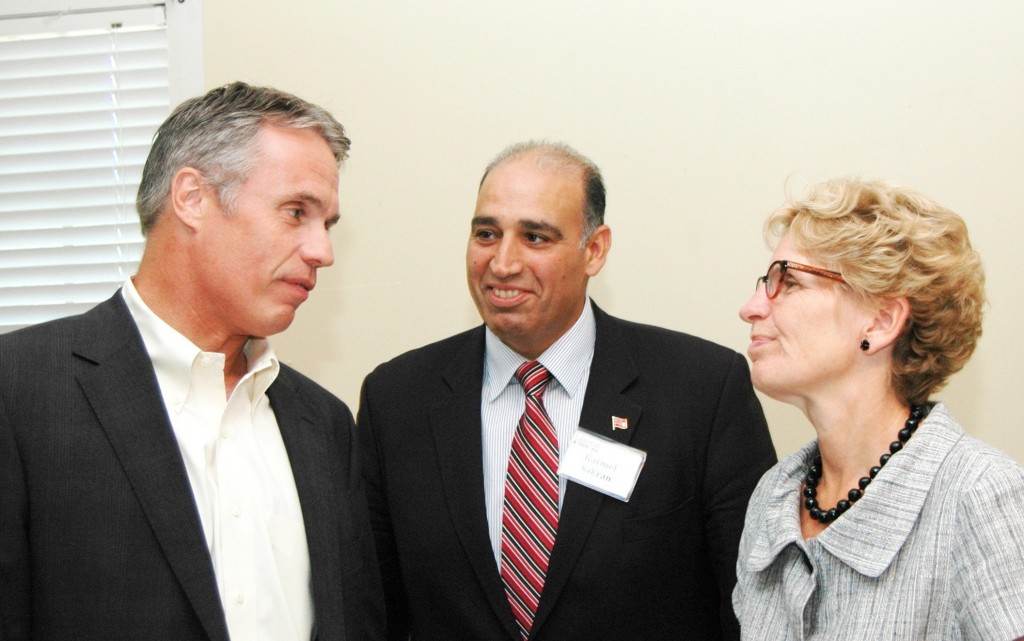 Do you get the sense that Mayor Goldring on the left believes a word Minister Wynne on the right is saying? She was delivering an election promise. They find they get a rock solid promise from the Minister of Transportation during an election, who at that time was Kathleen Wynne. After the election Wynne gets shuffled off to Municipal Affairs and takes her promise not to have a highway cut through the Escarpment with her.
All these comments came out at a presentation made by the Ministry of Transportation Environmental Assessment Project Team that was telling a Regional Planning and Public Works Committee where they were with their Niagara to GTA Environmental Assessment study.
The presentation began with the statement from the leader of the Ministry project team that the status quo was not an option, certainly set the stage. John Slobodzian, project manager for the Environmental study said “there will be more than 1.2 million additional passenger and commercial vehicle trips per day in the NGTA study area by 2031. He added that “transit is an important part of the solution, and it is assumed that plans and investment in transit over the next 20 years will result in an additional 700 million transit trips being accommodated in the GTHA by 2031. However, he added, we cannot assume that those coming to the region will travel exclusively by bus or rail.
New highway capacity was going to be required. The study team was conducting more in-depth explorations of highway expansion options
With that many trips in the offing the Ministry of Transportation people believe a new highway is going to be needed. “Those involved in moving goods agree that while there is a role for every mode, transport by truck is and will remain dominant.” New highway capacity is required and the Escarpment route is seen as one of the possibilities.
The Region was told shortly after the last election that there would be “one window” for them to work through with the provincial government and that would be Municipal Affairs which was fine by the Region – they always felt they were getting the run around from Ministry to Ministry. The politician that made a promise as Minister of Transport got shuffled over to the Ministry of Municipal Affairs – which is supposed to be the Ministry the Region is to deal with. Not a lot of trust between these players.
Add to that was the concern that with Municipal Affairs saying one thing, there would be no road through the Escarpment, the people over at Transportation were still beavering away at the Environmental Assessment that had “more highways” written all over it and the Escarpment looking like it was a really good place to ram a road through.
Lurking behind all this is the fear that if a new highway is built it will just attract more traffic and that doesn’t sit all that well with Burlington..
The NGTA Environmental Assessment study team has spent just over $6 million to date on this project. The options they put forward have continued to shift – whether this is the result of concerns voiced by the Region is doubtful for John Slobodzian says that he is aware of the comments the Region has made as well as stories in the media. He adds that there is a lot of mis-understanding out there but Slobodzian has yet to invite the media in for an in-depth background session.
His position is that he is conducting a full scale Environmental Assessment and that to be true to the process, nothing gets taken off the table until all the data has been collected and all the evidence is in. With the data in hand – the study team then takes their findings to the public for comment..
What does this more in-depth exploration of highway expansion options” consist of? John Slobodzian says they will be:
Assessing the relative merits of widening key highways such as Highway 403 and the QEW to determine if this option is preferable to constructing a new highway corridor
Considering a wide range of criteria and factor areas — from transportation performance, to natural and cultural environments. The innovative ‘building block’ approach looked first at how best to use existing transportation facilities and expand transit/non-roadway infrastructure
The draft Strategy is based on full implementation of the Regional Transportation Plan (RTP) by Metrolinx and GO 2020 Strategic Plan. All the funding for that RTP is not in place yet and, as Councillor Dennison pointed out, with the province facing a $16 billion deficit, and the Metrolinx plans estimated to come in at about $55 billion – there is clearly a challenge to be met.
The funding is going to be someone else’s problem. John Slobodzian has to complete an Environmental Assessment and he wants to be true to that process.
He speaks of:
Adjustable speed limits (speed harmonization)
Transit use of highway shoulders to bypass congestion
Reversible (contra-flow) lanes and moveable barriers
Initiatives that support freight rail
Optimization and non-roadway improvements are a core part of the Strategy, but the focus of the additional analysis will be on the roadway elements.
An ongoing concern is with any recommendation to construct a new corridor connecting Highway 403 to the 407 ETR.
Assessment of the alternatives has been undertaken at too broad of a level, without adequate quantification of the impacts. The primary objective at this stage is more focused analysis based on more refined corridors to identify and assess more specific impacts
Getting that done will generally involve:
Identifying new corridor alternatives connecting to Highway 401, 407 ETR, and other highways such as Highway 6.
Development of a conceptual plan for widening existing highways
Identification of a preferred new corridor alternative and a preferred widening alternative, followed by evaluation to identify the preferred alternative overall
The overall preferred alternative, will form the basis for Phase 2. There will be individual EA if the preferred alternative is a new corridor. There will be a Class EA if the preferred alternative involves widening of existing highways. A class EA is less intensive than a full scale EA.
Are you still with me? The average tax payer will have a difficult time following and understanding all this.
There are some very serious questions to be asked about any recommendation to widen the QEW over a new corridor. John Slobodzian will review the impact of an 8 lane cross section – 6 general purpose and two HOV – and ask how far beyond 2031 would such a cross section provide adequate capacity?
A Stage two look at the QEW options would look at a 10 lane cross section.
As one reads all these ideas and possible options you wonder if we are just going to pave it all so that cars and trucks can move from one place to another.
At some point some really basic questions have to be asked. Have we got this right or are we heading down a path that leads to a place we do not want to go? A question being asked is: perhaps a planning horizon of 2031 is not long enough?
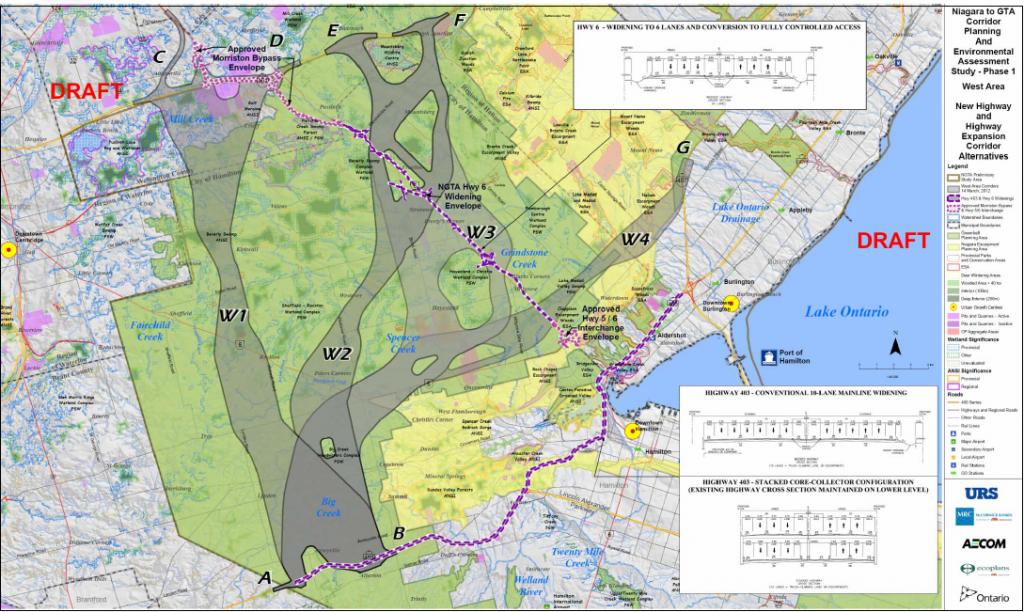 All those grey wavy lines are corridors; places the EA study team think a new road could be built within. While the corridor markings are very wide the study team points out that any road would only be 170 metres wide. ONLY? Each of the options shows increased traffic coming into the area. W1 would be a corridor running up what is nowHwy 6. W2 and W3 take a more easterly approach. W4 is considerably south of the original road that would run through Burlington’s Escarpment. Some are suggesting future freight forecasts are understated. Some suggest getting trucks off the road all together and use rail or five some thought to loading trucks on barges and float them along the edge of Lake Ontario into the GTA.. We didn’t hear any out of the box, blue sky thinking being done. It seemed to be the just pave over fields and drive along new roads.
Every planner in the world knows that if you build a road – cars and trucks will find it and use. Stop building roads and people begin to look for other alternatives.
Environmental assessment studies are what bureaucrats do – they research and set out the options. The Region and particularly Burlington would like to feel that their views are being heard and that there was some real dialogue between the bureaucrats and the citizens.
While we all enjoy the summer the bureaucrats will draw lines on maps and put together documents and present it to us in the fall at one of those Public Information events. In the past these were not all that well attended, partially because they were held during the day.
The bureaucrats can expect a better community response this fall – we’ve learned a lesson.
Once the public consultation is complete the MTO people hope to put forward their final strategy late in 2012 or early 2013. The time line the study team is working on shows construction as something that is eight years away.
Let us make sure we play an active, robust role in the determination of the recommendations that go to the Ministry. The Region needs to work at getting stronger ties to the people that make the decisions at Queen’s Park. As chair Gary Carr put it – this is a political decision.
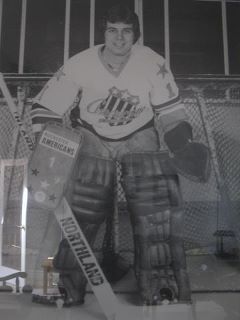 Regional Chair Gary Carr told the provincial bureaucrats that the 22-0 vote against any new road being pushed through the Escarpment was basically a shut out. And Carr knows what a shut out means – he might have to lace up again to win this one. You want to hope that he does, The bureaucrats are correct in the need to complete the environmental assessment and not to take anything off the table until they have completed their work; to do so would be against all the rules used to do a full environmental assessment. The Region can probably live with that – what they can’t live with is the constant change in messaging and maps that come out with new corridors that were not seen before.
The most recent set of maps had one possible corridor shifting south of Dundas in Burlington, between Brant and Walkers Line. When Councillor Taylor pointed that out the response from the bureaucrats was – “that’s not supposed to be there – we will have to fix that”, comments like those don’t instill confidence.
John Slobodzian was given a rough ride. He will undoubtedly put his report together, discuss it with his superiors up the food chain. Chair Carr suggested he go one better and have his “political masters” watch the web cast.
If you’d like to watch the web cast – it’s available at www.halton.ca

 By Pepper Parr By Pepper Parr
BURLINGTON, ON July 5, 2012 The Regional Fraud Unit of the Halton police have arrested a man believed to be operating as part of a larger crime ring in the Halton/Hamilton area, other GTA cities and across Canada.
Businessmen are contacted by an individual under the guise of wanting to do business with the victim’s company. The victim gets lured to either an area hotel or rented office for further discussions. Once there, the victim is asked to sit in for a poker hand for a game just finishing up usually to celebrate a birthday or luncheon, while one of the players has to step out for a call.
The victim wins his initial hand and is offered half the winnings. The victim then gets invited to continue playing. The next hand usually results in the victim losing a large sum of money for which payment is demanded.
 A friendly game is fine – playing poker as part of business with people you don’t know; you’re going to lose. The second variation of the scam is similar and usually involves a charity event or social setting. The victim is approached and asked if he has any knowledge of poker and winning hands. The victim is then lured into a game he believes to be a friendly, non-wager game. Once he loses, he is advised that he owes large sums of money and is pressured into writing a cheque or attending an area bank to supply the funds.
The same group is believed to have been involved in the same type of scam for years throughout the GTA and Canada. On July 4, Halton officers arrested Peter Andrew KUTI (64 yrs) of Port Moody, BC at a rooming house in the Toronto area.
KUTI has been charged with two counts of Fraud Over $5000 and has been held pending bail. He is scheduled to appear in Milton Court, July 5, 2012.
Investigators believe there may be other victims of the same scam and are asking anyone with information to contact Detective Sergeant John Mans of the Regional Fraud Unit at 905-465-8760, Crime Stoppers at 1 800 222-TIPS(8477), through the web at www.haltoncrimestoppers.com or by texting “Tip201” with your message to 274637(crimes).

 By Pepper Parr By Pepper Parr
BURLINGTON, ON July 3, 2012 Lowville’s problem came to city council a little over a year ago. Things were getting out of control at the park and John Timmis wanted council to look into the problems and work with the community to find a solution.
The problem was – there were too many people using the park – at times there were groups numbering 500 people and the community felt their park wasn’t built to accommodate that number of people who were part of a single group.
The people of Lowville do things a little differently. They are settled along Guelph Line where there is a crook in the road with the Lowville Bistro dead ahead. Drive on into the grounds, hang a right and you are in the parking lot where parking is free and you can wander around to your hearts delight.
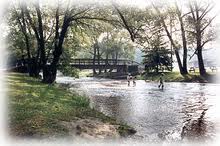 A river runs through the park where the salmon spawn and children get to play. The people of Lowville tend to gather their almost every morning while they walk their pets and just get together to gab. They see this as their community park and while they are quite prepared to share the space and they don’t mind having to go in after a weekend and tidy up a bit – they think the park is being used for something it wasn’t built to do.
Lowville is part of rural Burlington and part of their affairs fall under the hand of Councillor John Taylor who knows just about all of the people in the community by first name.
The city decided the park needed some planning and after a bunch of meetings they got together in the old one room school house and talked through some ideas the residents had.
This was one of those situations where the ideas were coming from the community. The city hall staff weren’t on site to defend a report or a series of recommendations – they were their to listen to the ideas the residents had. And the residents had some pretty sensible ideas. While nothing had been costed out – the ideas looked as if they were well within a decent budget.
Councillor Taylor sat at the back of the room – he tends not to be a front and center guy. Staff were there to listen and ask questions.
Several days after the Lowville session Taylor took part in a Community Engagement Charter work shop where he heard about the need for the citizens of Burlington to organize themselves and have a Charter setting out their rights and what they could demand of the city.
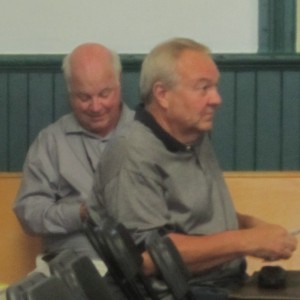 John Timmis, on the right, took community concerns about the Lowville Park to a city council committee meeting – sometime later the residents and city staff meet to work out a solution. The folks in Lowville didn’t need a Charter – they just wanted a conversation – and that’s what they had. Lasted close to an hour and a half. No cookies or coffee – just steady back and forth, give and take, where Rob Peachey, Manager of Facilities, Parks & Open Space, addressed more than half the people by their first name. It was almost as if this was an extended family talking about changes they wanted to make to the way the family property was run.
The concerns the residents of Lowville had was not with people coming to the park – it was with the number of people and then with the way people behaved while they were there.
Anyone from Burlington can call city hall and request a permit to use one of the five permit spaces on a weekend. And that’s where part of the problem crops up. The city gets calls from someone who lives in Burlington requesting a permit which is for an association – and at times there are hundreds of people arriving.
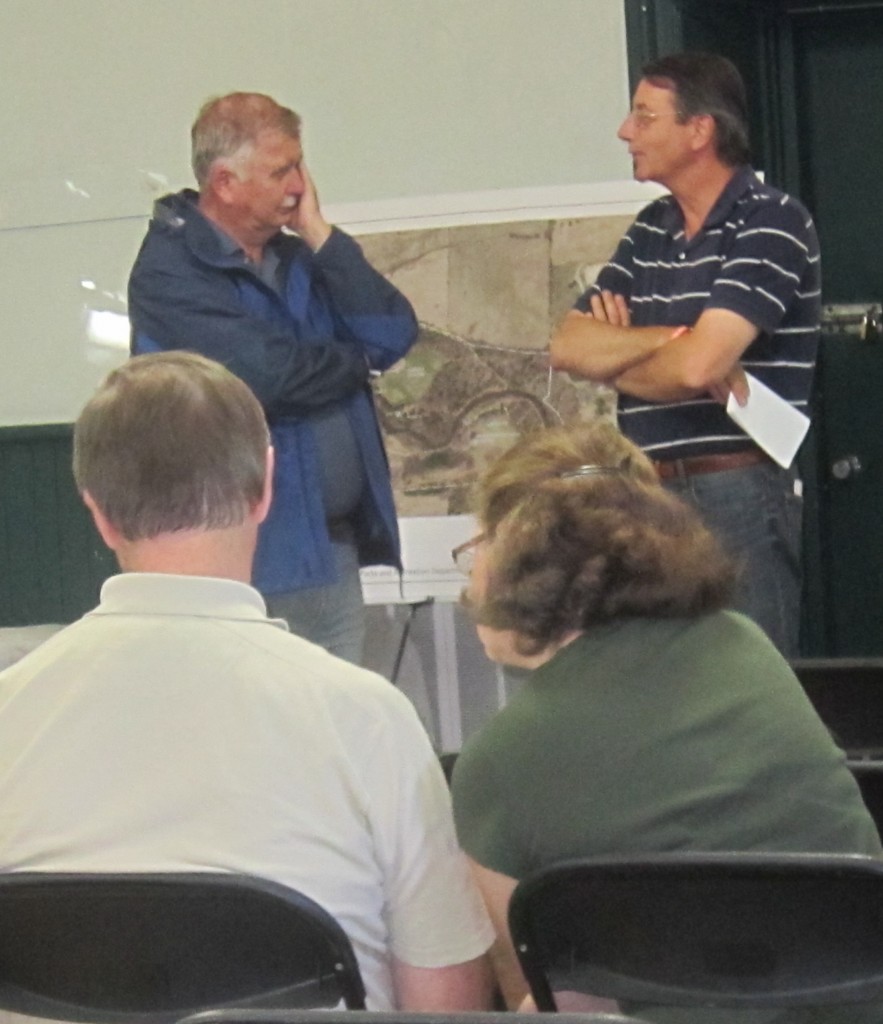 Lowville residents gather with city staff in a century old one room school house to talk through the problems they have with their local park . The residents of Lowville saw their park as a place where families would gather in groups of maybe 40 or 50 and have a family picnic. But when the word got around that Lowville was a place that was inexpensive, the parking was free and the river running through the property was a great place for children to play and experience nature first hand, it became the location of choice for a lot of associations and companies who wanted to hold a staff picnic. It also became a place for very large groups that had no attachment to Burlington. The demand grew until it got out of hand.
The large crowds, some of whom brought along large blow up recreational devices and then power generators to keep them filled with air, was to the minds of the Lowville people, getting beyond a local park. They wanted city hall to put some boundaries in place.
The permit fee structure did allow for people who were not from Burlington. For the smaller parks the rate is $60 for residents and $120 for non-residents; for the large park the rate is $118. For residents and $237 for non-residents. The city determines who is a resident by the address they mail the permit to.
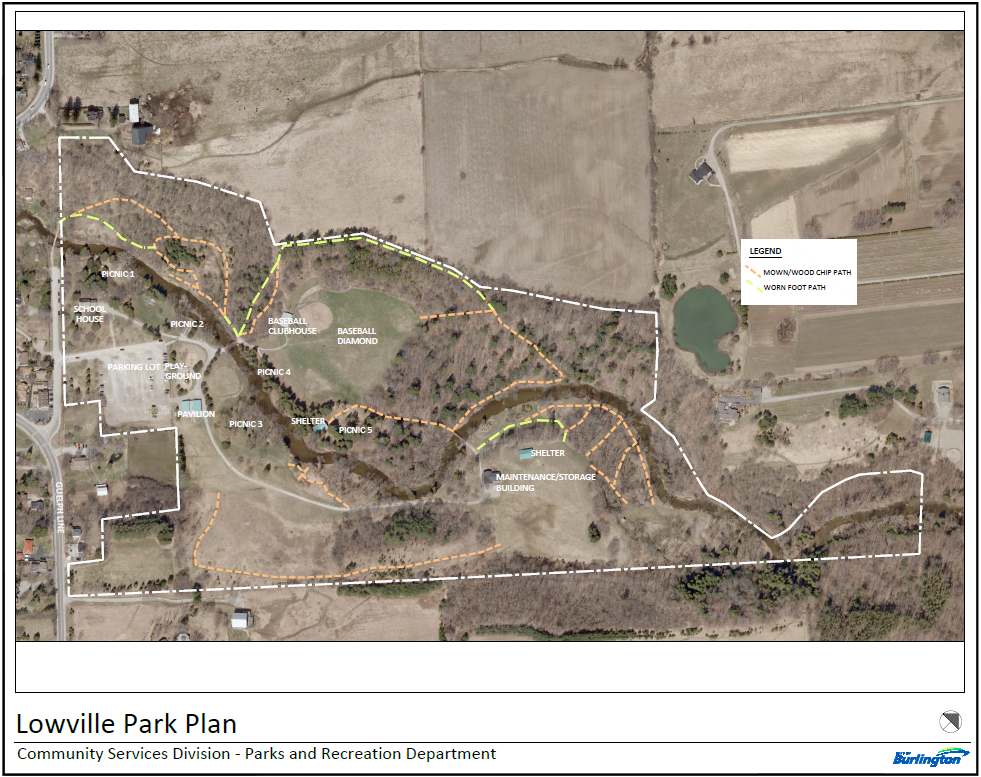 Lowville Park is one of those places where you can walk around for hours and just enjoy being out in the country. Picnic areas can be reserved, parking is free. There are five permit areas in the park – that’s down from the seven that existed several years ago. Permit area 1 can handle up to 110 people, same for areas 2, 3 and 4. Permit area 5 can handle up to 250. When there are very large groups the city hands out two permits for two areas.
The large groups create parking problems and people began to park wherever they could find a space. The city brought in a towing truck recently and had it just sit there; that was certainly a deterrence but even with that parking tickets were handed out.
Companies get a permit and hold their staff picnic at the park and the residents don’t feel this is what the park was designed to accommodate. The residents believe that if they change the look and feel of the park that behaviour will change. The came up with some design changes that included putting trees in the parking lot area. That would make it seem less like a huge parking lot.
They want to build a small “island” at the entrance to the park that would have a large map of the grounds, some public notices and trees to soften the look of the roadway going in.
They didn’t want paved pathway; – use stone dust if you have to but no paving.
They want to see large areas of the back end of the park with grass that is not mown but left to grow naturally and create more of a natural sanctuary. Someone suggested changing the name to Lowville Natural Sanctuary – with the name telling people what the park was really about.
The residents felt the park was intended for smaller family gatherings – where there is space for 30 picnic areas that could accommodate 25-30 people at each. Scale is the concern for the Lowville residents. They just see a wonderful nature park with a stream running through much of it where the salmon spawn and where children can get a better understanding a nature in a real setting.
Large blow up toys with gas generators on hand to keep them filled with air is not what the community thinks the park is about and it certainly isn’t what they want. They see it as a natural environment and want to keep it that way.
There was no charter needed to make this meeting happen. Councillor Taylor sat in the corner of the one room school house and counted at least 30 solid votes in the audience. Citizen engagement at its best would have been his comment had you asked.
Part of the problem is that no one knows who has a permit and who doesn’t. There isn’t an attendant at a gate. People just drive in and go to where they think they are supposed to go.
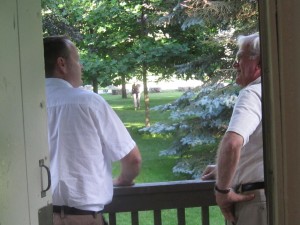 Rob Peachey, on the left, Manager Parks and Open Spaces for the city, talks through some solutions to managing the very large weekend crowds. The city doesn’t want to put an attendant in without some offsetting revenue. Parking is free as is entrance to the park and the Lowville people want to keep it that way. They were opposed to charging for parking but they did want some control over the way the grounds are managed, particularly on the long weekends.
There was a point when the park had more than 1200 people on the grounds – with the reduction of two permit areas that capacity is down to 830 people which is about what the washrooms and the waste bins can handle.
The Lowville residents have the feeling that their community park is being overrun and put to a use for which it wasn’t designed. “This is a natural park but it has become a destination for large groups that want an inexpensive place to hold events for really large number of people.
The Lowville residents put their ideas up on a large map of the park with overlays showing the changes they thought made sense and then had a community discussion about the possible changes while city staff looked on. Staff then commented, asked some clarifying questions and it was a “we will be back to you in the fall.

 By Pepper Parr By Pepper Parr
BURLINGTON, ON July 4, 2012 The Chair of our Regional government, Gary Carr, says: “Summer in Halton Region is a wonderful time and our waterfront and beaches are some of Halton residents’ favourite destinations.”
OK- you expect the chair to say something like that.
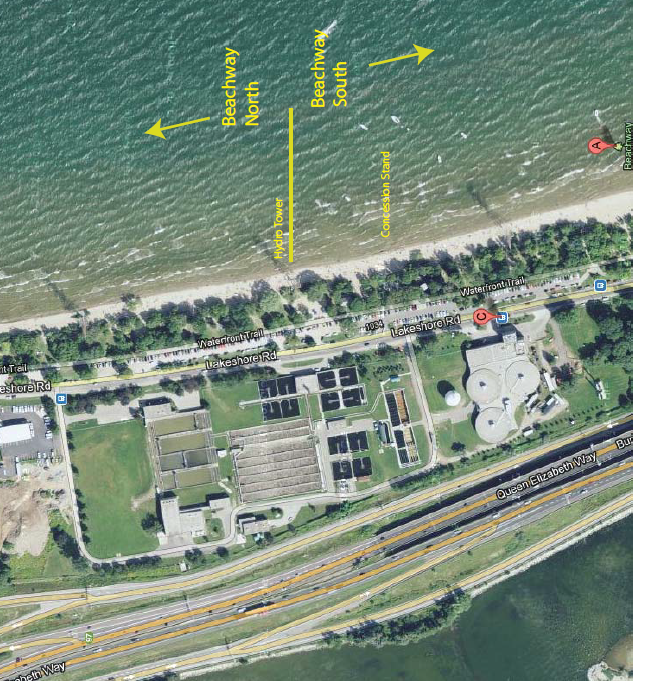 If the water on the north side of the boundary is not safe for swimming, why is the water on the south side safe for swimming. And is there a sign on the Beachway explaining the water isn't safe to the public that uses the Beachway Park? Carr goes on: “To help residents stay healthy while being active, the Halton Region Health Department monitors the water quality at recreational beaches in Halton from the first week in June until the first week of September. Monitoring and samples are taken once a week at all public beaches.”
“The biggest influences on beach water quality are things we don’t have much control over such as: Environmental factors: the amount of rain water, wind & waves; warm water temperatures, large numbers of geese, seagulls, ducks and other water-birds.
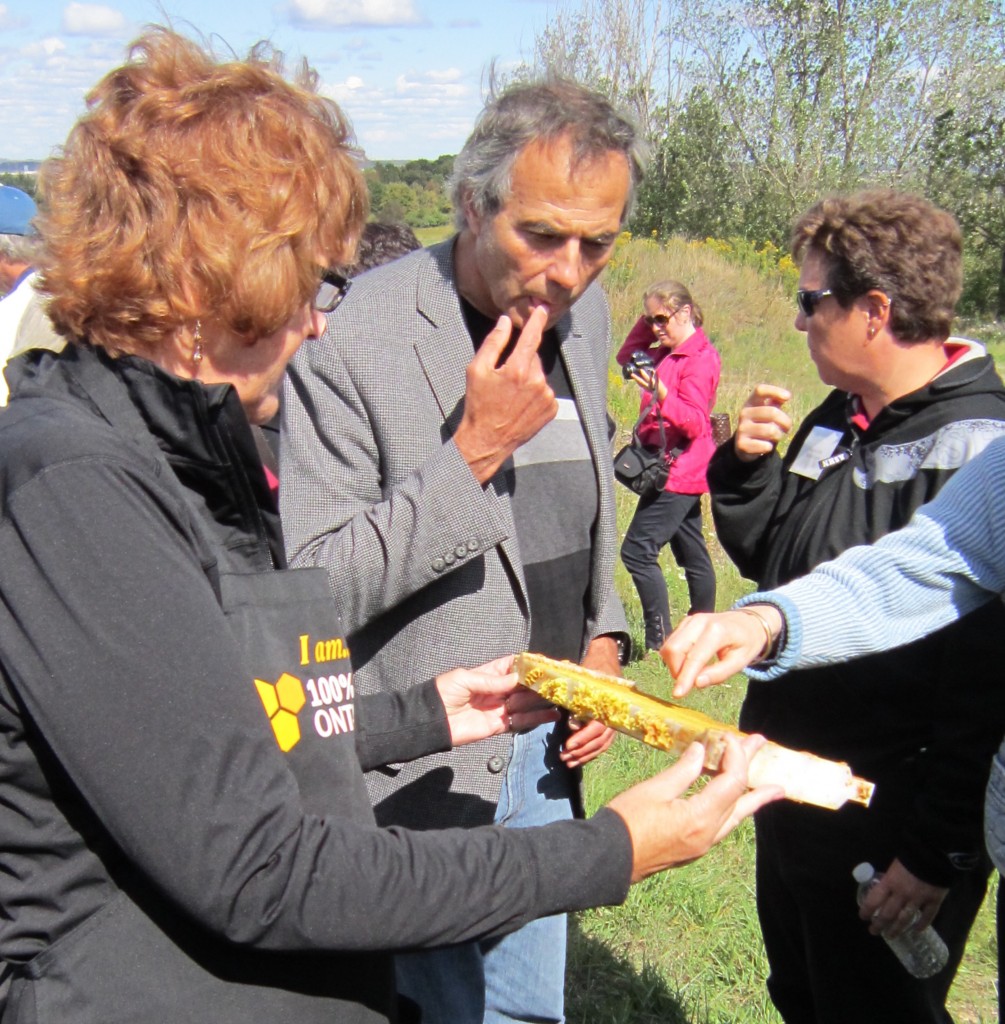 Regional Chair Gary Carr tasting honey while on an agricultural tour. What Carr fails to mention is that when we feed the geese they just poop more and that poop is the biggest part of what pollutes the water. Many people don’t know that.
Every Wednesday the Region releases water quality reports for each of the parks in the Region. In Burlington they break the Beachway Park into North and South. It took a while to get the boundaries for North and South, which we post on the report we publish on water quality.
Now take a look at that map and tell me how one differentiates between the quality of the water on the South and the quality of the water on the North?
Better yet, how do people know where the boundary is? We get a lot of people coming to Our Burlington, but truth be told, everyone on those Beaches last weekend didn’t visit our web site.
So how do they know which part of the lake is safe and which part isn’t?
Wouldn’t it be a great idea if the Region posted a sign – and then an explanation on the factors that make the water on the northern part different than the water on the southern part?
And while they are at it – how about a dozen or so signs posted along the edge of the lake explaining why those far too fat geese should not be fed scraps of food. Use clear, straight to the point language – feed those geese and swim in the water their poop pollutes. That will get the message across.
Summer has just begun – still time to get those signs up.

 By Pepper Parr By Pepper Parr
BURLINGTON, ON July 3, 2012 Following the rules and convincing your customers you can be relied upon is part of running a business. Produce Planet did all the things a small independent is supposed to do – except for that following the rules part.
Alex Iabs needed to let people know he had fresh fruit and vegetable from local farms available on his shelves and he put out almost as many signs as an election candidate would along the sides of Guelph Line south of Upper Middle Road to draw traffic to his store on Mount Forest.
One of the bigger supermarkets called the city’s bylaw office to complain. The bylaw office called Alex Iabs and said the signs could not be set up on the side of the road. The city could have fined Alex Iabs but instead just explained the rules and expected him to follow those rules. Alex Iabs then hired young boys to hold up the signs. That was legal.
So far so good.
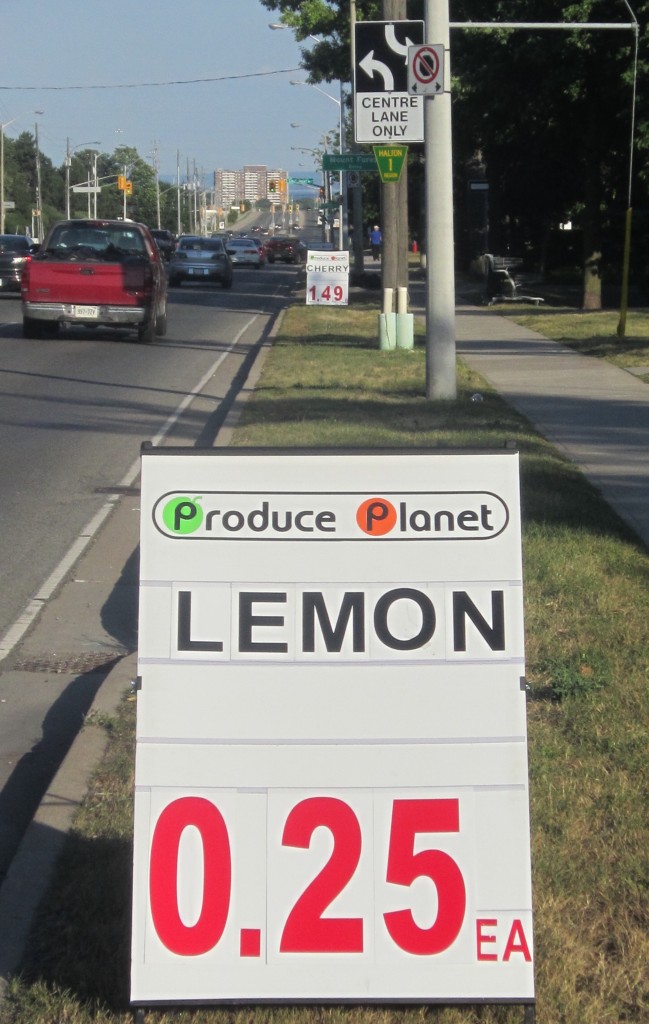 City hall told the merchant signs like this were a no, no. Why then would a merchant break the rules? what else would this merchant do? But over the weekend Alex Iabs put the signs back out on the road side with no one holding them up.
Alex Iabs knew that was against the bylaw but he also knew that there was no one at city hall on the holiday Monday to take a complaint call.
Slick you might say.
The message to me was that Alex Iabs would do whatever he had to do to drive traffic to his store. If putting signs out without young boys holding up the signs was something he thought he could get away with – that he would do.
The message to me was that this is a store that wants to sell me the food I am going to put in my stomach; I don’t feel as confident or as supportive as I used to about Produce Planet.

 By Pepper Parr By Pepper Parr
BURLINGTON, ON July 2nd, 2012 The city got its first look at what the people behind the creation of a Community Engagement Charter (CEC) are thinking. We saw a rough structure that spokesperson Chris Walker called “bones with no meat on it yet”.
The meeting was part of a council Workshop where no one got very excited about the presentation being made. This was the first chance council got to see what the CEC people have been doing for six months. There wasn’t that much to show for their efforts.
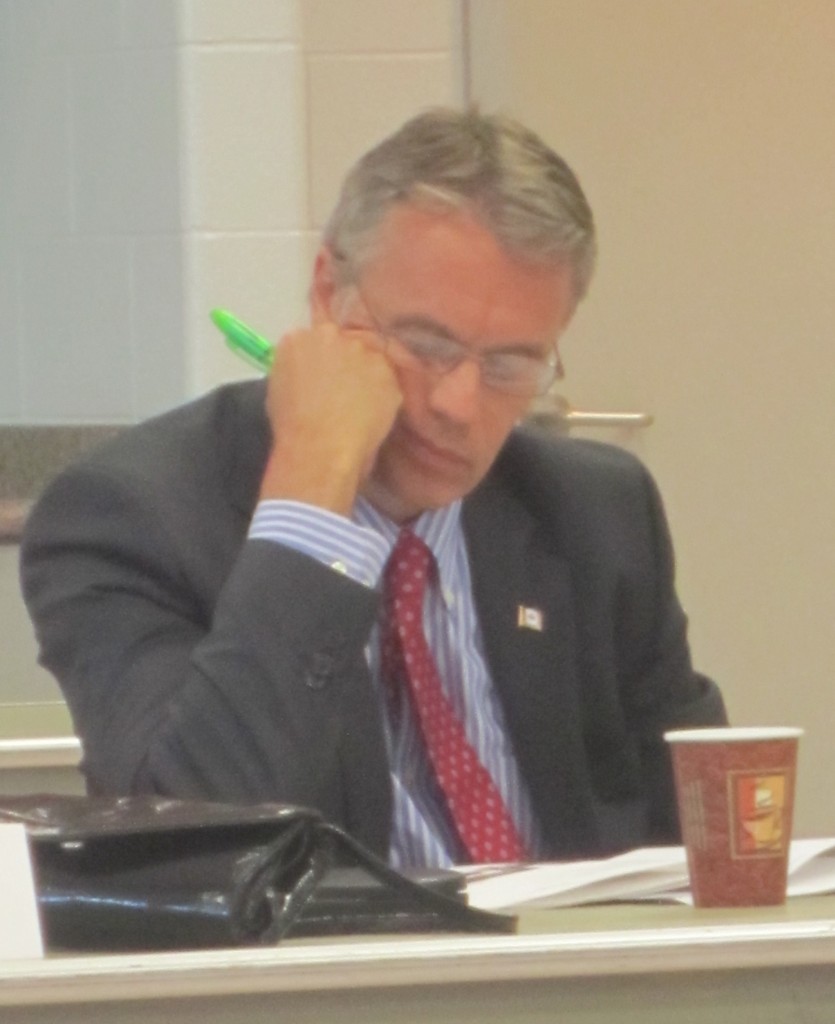 The Community Engagement team didn't manage to engage council members at a Council Workshop - once council member didn't ask a single question. They Mayor had difficulty staying focused. The coffee didn't help. The meeting had a quorum but not much more than that. Councillors Taylor, Lancaster, Craven and Meed Ward were at the table. Councillor Dennison was in the room but not at the table for an event which was held in the community at Tansley Woods. Councillor Sharman didn’t attend. The Mayor was there but – well the picture tells that story.
Community Engagement Coordinator Christine Iamonaco introduced her team, which we learned consisted of 24 active participants; 86 people monitoring Basecamp, which is a web location that posts all the documents and the flow of information used by the Engagement Committee. There were 50 people participating via the Basecamp set up.
That’s a total of less than 100 people who were attached to the team in some way. Clearly Community Engagement hasn’t caught on fire in Burlington. There were more media and politicians than there were public at one of the community meetings in Ward 1.
One can’t blame Iamonaco for the turnout – the idea or belief that the city needed to improve the level of citizen engagement isn’t that wide spread. No one cares – until there is an issue that impacts on them – then we get a turnout that fills an arena meeting room.
Let’s first take a look at what the Community Engagement Charter people want to see changed and then look at how things work in different parts of the city when there is a problem.
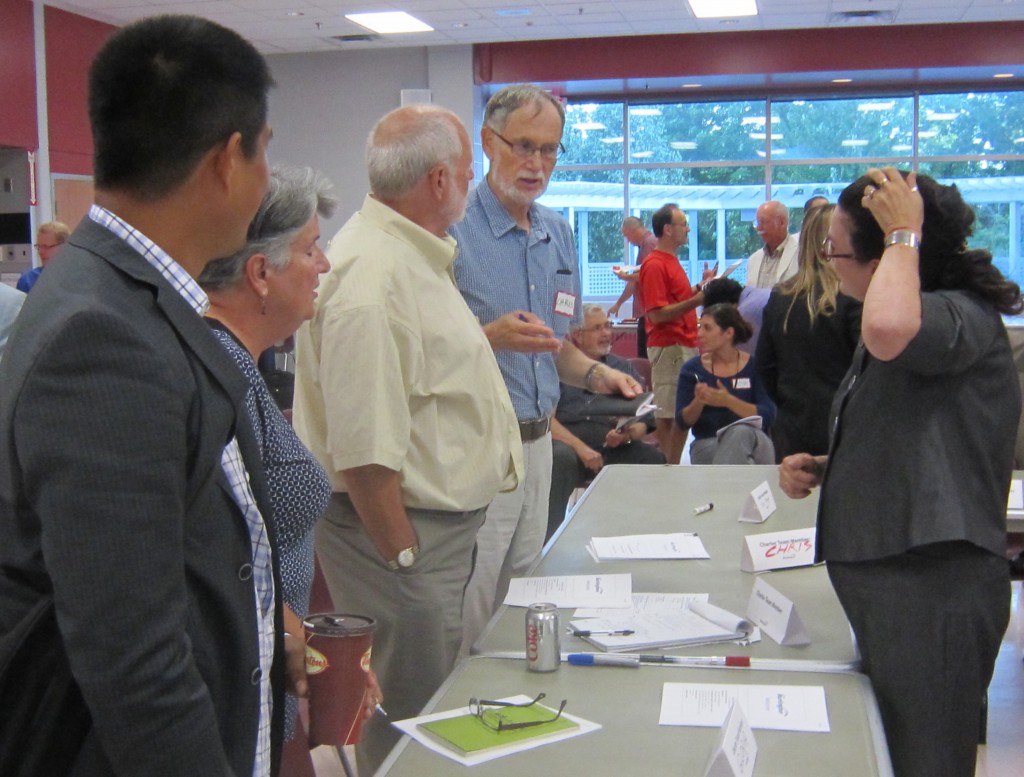 Members of the Community Engagement Team do a debrief after their Council Workshop session. Chris Walker is in the center. They put forward a Vision Statement – these things can be atrocious and are at times just “happy talk” or an ideal that is so far from reality that they aren’t taken as serious. The Community Engagement Charter team put this forward in a vision statement. They saw it as a Big Hairy Audacious Goal to “make Burlington the most engaged and connected community in Canada involving all generations, socio-economic and cultural groups”. No wonder the mayor was yawning.
What does that mean and how do you do that? The Mission Statement, one step beneath the Vision , explained how this would “…provide Burlington citizens, city council and city staff a plain language living document, that promotes active and meaningful citizen engagement in City of Burlington planning, policy-making and decision making processes.” Whew!
The Charter the CEC people want to put in place will work from the Vision through the Mission statement and be truly unique because it will be “created by the community for the community with an implementation plan that aligns with the Strategic Plan, the Official Plan, e-government strategy and “operationalizes” the Community Engagement Charter.” When the Charter is in place it will be reviewed annually for a period of time and then reviewed when the Strategic Plan is given a review.
And at this point I expect I’ve lost whatever readership there was for this story.
How did we get to where we are?
The city spends tens of thousands of dollars every year on advertising – and gets very little in the way of a return. Everyone talks about how e-government is going to change everything for the better when we don’t know yet what the city is planning nor do we know what the community wants.
In his remarks Walker made a very good point on the Workshop setting not being open to any back and forth between the CEC team, the few members of the public in the room and the city council members. It would have been interesting to watch what happened had Walker asked for a change in the format of the meeting and see how the Clerk and the council members reacted.
Everyone in the room had great expectations for “e-government”; a concept that has as many definitions as there are people using the term. Burlington recently brought Brent Stanbury back on staff to get the “e-government” process up and going. Stanbury has been given some direction by Budget and Corporate Services General Manager Kim Phillips but those have not been shared with the CEC team or the public in general.
The Community Engagement Charter team, began by looking at every example of community engagement they could find and produced a three inch binder with page upon page of background material.
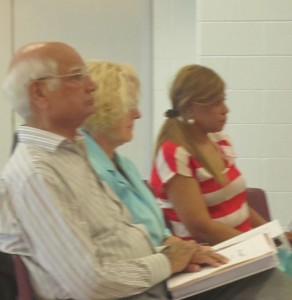 Members of the public didn't get a chance to engage the council members on just what they wanted from a Community Engagement Charter. They came to the conclusion that Burlington’s existing practices are good and there are opportunities for enhancements. That’s not what the Shape Burlington report had to say when it was published. Several of the people on the CEC team were core members of Shape Burlington and it’s offspring Shaping Burlington. The fire would appear to have gone from the belly of the people who were there in the early days – back in April of 2010.
The framework they are working from emphasizes city council commitments and citizen responsibilities. They want to identify existing best practices and include engagement guidance for city staff.
The team has identified commitments city council has made and wants to ensure those commitments are met, which means some form of ongoing monitoring of what happens at city hall. Shaping Burlington has done very little in the way of monitoring what gets done at both committee and council meetings.
Setting out citizen responsibilities is the kind of thing that gets taught at the dinner table. Sort of like the Ten Commandments – I know what they are – maintaining them is my problem. Everyone knows what their civic responsibility is – the first being to vote and with a current 34% range turnout – well we know which direction we want to go in on that one
The Charter that gets produced is going to be a 20 page document- that’s a relief. A Citizens Responsibility Guide is a little presumptuous. Bring Commitments to Life – that’s one that needs to be unpacked.
The Charter Team wants to start with the four commitments the city has already adopted:
citizen involvement;
transparency,
accountability
and adherence to the public engagement continuum as set out in the IAP2 process the city has adopted.
The CEC team want the city to be open to new ideas – bit of a stretch there. Politicians will always say they are open to new ideas – but that’s about it.
Early and broader notification – YES!
Customer service – city hall has some ideas they are working through – but they appear to be doing so in a room by themselves. This is one where the CEC people could have a significant impact.
The Region of Halton has a citizens panel – they call it MVP – My Point of view. Burlington would be well served if it had such a panel – say 150 people selected randomly that they communicated with electronically from time to time. Every year they would renew the panel.
The CEC team could have, and still should, get out and do some polling – get out and ask people what they think and feel – be as interactive as you want the people to be. There is a tinge of the academic to much of what the CEC people are doing. Democracy is a messy, down at the street level business – it is noisy, there is nothing polite about it.
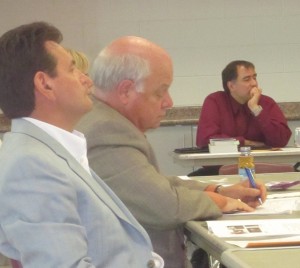 Two of the city councillors were not at the table and one didn't ask a single question. Councillor Craven chose to be mute. Democracy tries to ensure that everyone’s needs are fairly met and that the rule of law overrides everything. Which is fine – but when your specific needs are being trampled upon (they closed off your street so that bicycles could drive up and down for a couple of hours) then it doesn’t appear all that democratic to you.
Two examples of what the city is doing to improve customer service are telling: There will eventually be a single cash counter. If you are there to pay a parking ticket and then buy a ticket for an event – you now get sent to different counters. Centralizing this will make things much more convenient. Good move.
Disseminating information: – there are some moves here that are troublesome. The city is shoving everything out to their web site – but the web site is not easy to navigate and the search facility is not user friendly. The city has brought back the person who created the internal COBNET used by staff to talk about things you are not supposed to read. This is a level at which the CEC people want to lean very heavily. Civil servants by nature don’t naturally share information. Ask a question and they will ask you why you want the information. That’s just the way they are built – but that doesn’t mean they have to stay that way. This is what Shape Burlington meant by that information deficit.
In their deliberations the CEC people brought forward a definition that I’d forgotten I knew – community capacity, which is the capacity a community has to participate and the level at which a community participates in the growth and development of the community.
As the CEC team puts “meat on the bones” of the framework they have in place one hopes they will see opportunities to set in place ways to increase that community capacity. This isn’t easy stuff to do but there are some pretty bright people within that 24 member active core group.
The CEC report suggested a pilot project to support neighbourhood development; experience shows those approaches don’t work. People will agitate when they are upset. People will organize when leadership appears. Councillor Meed Ward created a community advisory committee that works – they don’t always agree with her but she is open and listens. Craven has been doing it for some time in Ward 1.
Each of the council members has an organized relationship with their communities; some are better at it than others and each brings their personalities and their feel for their communities to this task. The wiser municipal politicians will develop and maintain the strongest possible relationship with their community. It’s the cheapest form of campaigning they are ever going to find and they get paid while they do it.
Meed Ward attached herself to the Save our Waterfront organization and used it to propel herself into office. She made the pier her issue and is closely identified with what happens to that project. In Burlington the level most people participate at is galas and fund raisers. You could be out almost every weekend of the year at some event. This city is very open to helping.
What it isn’t doing all that well is being a real meaningful part of the civic process – and a large part of that is because there has been no one pushing against the edge of the envelope. Burlingtonians just accept that whatever is going on at city hall is OK; that whatever is going on at the hospital is fine when there are very real concerns at city hall – our transit problems, determining what kind of a city we are going to be 10 to 15 years out when we have more seniors that have to be taken care of and we don’t have plans or capacity to take care of them.
And the 90 + people that died at the hospital because the place wasn’t kept clean tells you what was going on over there. Public institutions are a bit like children – they need constant watching. You have to say – “no, don’t do that, please do this, I would prefer that you do that”.
There does come a time when your children get it and don’t have to be watched in quite the same way. Your elected officials and civil servants have to be watched all the time. Not because you can’t trust them – but because they don’t have any of their own skin in the game.
Let me expand on that. The little guy who runs a shop on Brant Street or the car dealership on Fairview pays a lot of attention to the people who walk through their doors – because if those people don’t come back – those business people don’t eat quite as well.
The folks at city hall don’t have to be efficient; there is no incentive to be efficient – they don’t own the business. They will perform well if there is top notch senior level management people in place setting the standard. Burlington has not in the past been blessed with that level of talent at the city manager level.
This city just parted ways with a senior level manager because he wasn’t top notch. Civic administration needs to be groomed and made professional; doing that calls for a leadership that demands professionalism. A bylaw report got sent back recently to be “cleaned up” because it wasn’t good enough. That has to happen more often.
A city manager will catch those things and if he or she is doing their job – there will be phone calls made. In Burlington – if you work at city hall and you are doing your job – you get a little note from Jeff Fielding the city manager saying thank you. If you work at city hall and you don’t get a note during the year – you might ask yourself if you are as professional as you should be.
The Check List idea was a good one. The community could create a check list and then monitor the city’s progress and put the tick marks in the boxes and have them posted in a public place. (This is something Our Burlington will look into – we just might be able to do that.)
Early successes – here they were into stretching it mode. The Mayor speaking at an Innovations in Public Consultation and Engagement conference can’t be described as an “early” win. Describing Burlington as a recognized engagement leader is self-serving at best.
This city is still stuck at describing ourselves at Canada’s # 2 Best city to live in. Folks – that survey was a magazine circulation building exercise – something the people at Economic Development missed when they featured the #2 standing in a full page, full colour advertisement in a respected business.
The 26 people actively participating in the development of an Engagement Charter is just not a very impressive number and makes it hard to claim that there is large community involvement in this endeavour. That is not meant to diminish or dismiss the work being done – but let’s be frank with what the CEC team has managed to get done in six months.
How does a community express it concerns? How does a community take an active part in its development and growth? The first step is having a public that knows what it is talking about and that means keeping them informed.
And that basically was what the Shape Burlington report was all about. It said the city had an “information deficit” and that people didn’t know what was going on and that city hall made a lot of decisions without asking the public what they thought or felt.
The CEC team now takes the framework to the community. They have some plans for an innovative approach to talking to the public on the downtown car free Sunday, July 15th. They should certainly have a good crowd to work with.
More community engagement in September and then taking the Charter to the public for review in October. In December it becomes a report to city council where the CEC would like to see the document approved as city policy and procedure.
Funding is always important: will the city commit real long term dollars to community engagement or will the final report the CEC people submit get the “receive and file” that this interim report got?
Don’t expect city hall to lead a review of whatever comes out of this process – it will be up to the community to push for what they want – that’s a lot of work for 26 people to do. It has been done before however.

 By Pepper Parr By Pepper Parr
BURLINGTON, ON July 2nd, 2012 Canada Day – 145 years out and Burlington celebrates the day with Ashley MacIsaac on stage doing what he does so well with his fiddle. He then tried telling the citizens to do everything they can to ensure that the current prime minister isn’t in office on the 150th anniversary. That appeal fell on deaf ears.
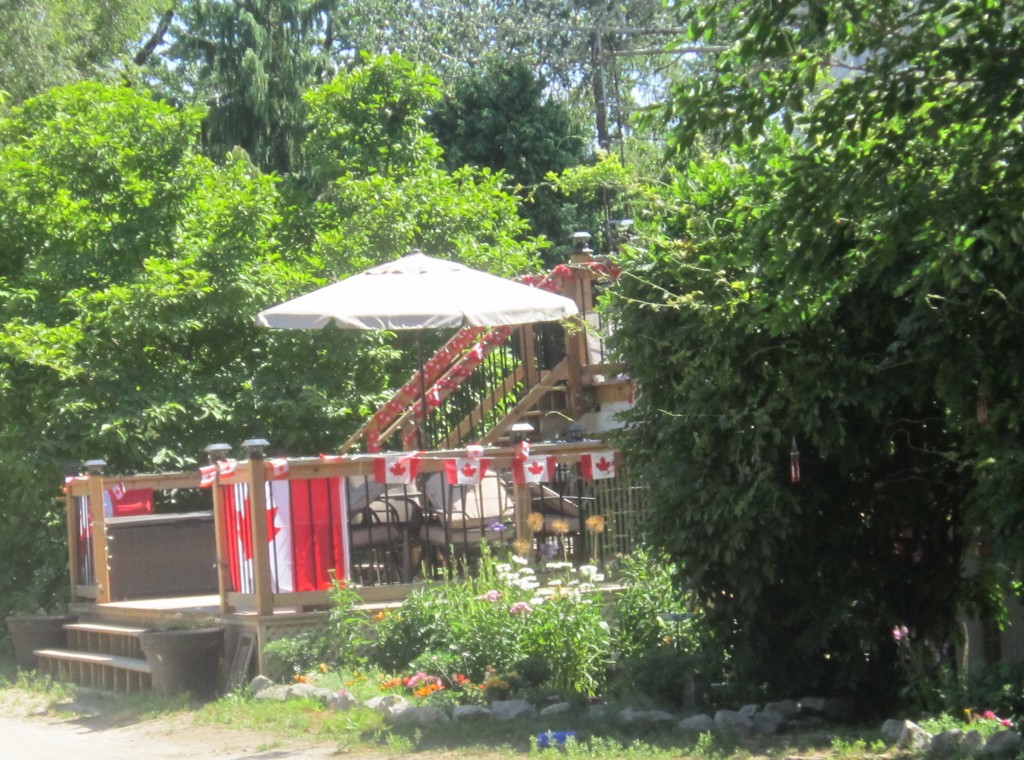 Homes on the Beachway left no doubt about what they were celebrating. He was as good on his fiddle as he usually is – but he shouldn’t try to sing.
Spencer Smith Park filled up as the evening approached after a day when a crowd of new Canadians took to the stage one by one to be made “Canadians” with Citizenship Court Judge Frank Hayden swearing them all in and giving them his “being a Canadian” pep talk.
It was a wonderfully sunny day; crowds were out and the Beachway part of the city had hundreds of families out on the grass with hundreds of kids in the water.
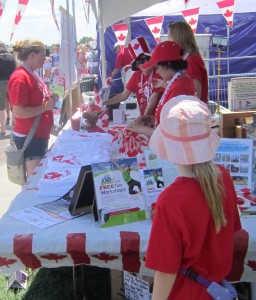 If you didn't have a bright red T shirt - there was a booth you could buy one at. Parking was close to impossible and the city had additional staff handing out parking tickets. There was a subtle change in the uniforms the men were wearing – instead of the shirts with the By Law enforcement shoulder patches these men had Provincial Offences Enforcement, which meant they could give people tickets for provincial offences and not just parking – no drinking in public parks.
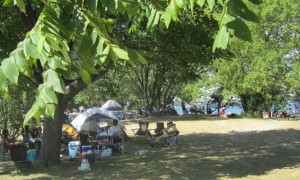 Families out on the grass - enjoying great weather and a day to remember. It was interesting to note that the people on the Beachway tended to be large families that had hibachis and all the gear needed for a picnic. Many were people of colour, dressed traditionally and while quiet were very friendly. Soccer was the predominant sport but we did see one little tyke who had put together twigs for a camp fire in what any Scout master would have given him a badge for. The child was being very well supervised, there was no chance that he was going to light a fire.
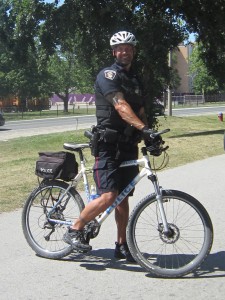 Police officer told us he was on "bikini patrol" and that he loved his job. The Regional police had officers out on bicycles patrolling what we were told was a quiet day.
 Her name was Jade - she just seemed to love the camera.  Captivated with the cell phone - this young man was having the time of his life. The mood and the scene at The Joseph Brant Museum was quite different. There was entertainment for the young people and displays to look over with plenty of shaded space to sit and eat more of that ice cream with fresh fruit than we perhaps should have. Quite a different feel than that out on the Beachway.
The Canadiana Tent the city set up was both a smart thing to do and the best deal available on the waterfront during the weekend. It was a place to sit and relax, for those who had been on their feet for several hours, the $20 price was worth every penny. You got a meal, an alcoholic beverage, a cold drink, a Maple Leaf cookie and reasonably comfortable seats plus shade. You can do that one again city hall. And that extra drink you wanted was nicely priced – less than we paid for the same drink in Grimsby the day before. You also got a small flag.
As dusk approached the waterfront filled up quickly for the fireworks.
The SeaDoo races around an obstacle course kept the air filled with the sounds of those roaring engines but no one seemed to mind.
It was just one of those pleasant sunny summer days – no doubt whatsoever that summer was here and staying for awhile. A national holiday, celebration of the founding of the country. Most born in the country Canadians take it all for granted; those who chose to come to this country knew what they were doing. We can learn from them just how fortunate we are.

 By Pepper Parr By Pepper Parr
BURLINGTON, ON June 30, 2012 Friday was the first day for the new fresh produce market in the downtown core. It was put together quickly; it was a little haphazard, it had a lemonade stand and there was value plus fresh vegetables all set out on the edge of a private parking lot steps away from a lush garden – it was Burlington’s latest downtown Farmer’s Market that will be known as Plan B.
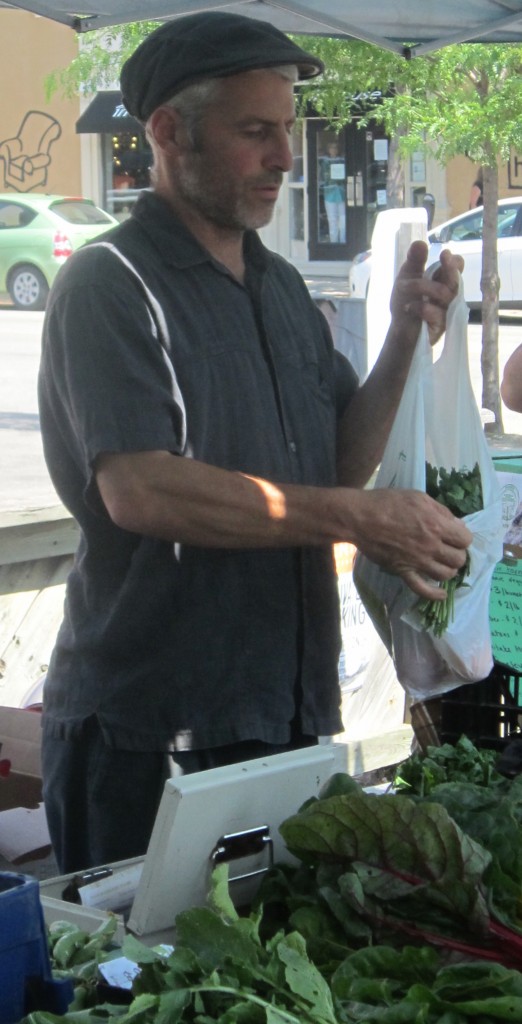 Fresh from the farm, one of the selections at the Farmers Market that will be open every Friday from 11-2 Barry Imber had been thinking about the idea for more than a year and decided it was time to stop thinking and time to just do it. And so there it was – the first of a planned program of having the market open every Friday from 11 – 2 and see what happens.
And they showed up. There were no line ups but there was a steady flow of people inquiring about the cheeses, the fresh pork that was wrapped and in a cooler. Those who are focused on “fresh from the farm” can place their orders by telephone (there will be a web site up soon where you can put in your order) and pick it up at the market on Friday.
For those of you who want a special cut of pork this is about as good as it is going to get. Featherstone Farm hopes to cultivate a clientele within the downtown core that wants that extra freshness and a chance to talk to the people who run the farm.
The market is called Plan B, which is part of a different way of feeding people. It is part of what is known as a CSA model – Community Shared Agriculture, that restores the link between the farmers and city dwellers. Successful in Japan and Western Europe since 1965, CSA today operates on approximately 1000 farms in North America.
With traditional CSA , local households purchase subscription “shares” of the year’s harvest from a local organic farm. CSA “shareholders” pay for their produce at the beginning of the growing season, providing the necessary start-up capital for farmers to purchase seeds, supplies and soil amendments, eliminating their reliance on expensive bank loans and helping to pay for the real cost of food.
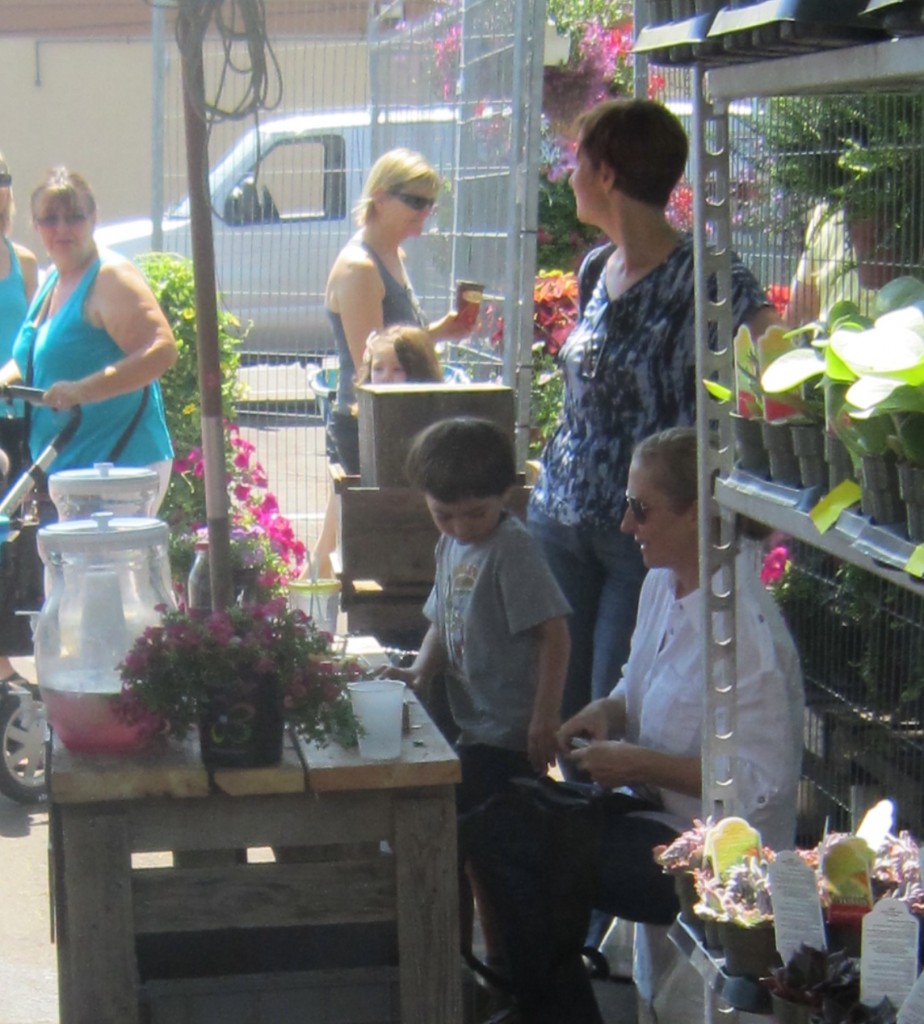 Lemonade stand with a great selection of potted plants as well. The place had a good family feel to it during the first Friday. The market on John Street, right behind Centro Gardens isn’t going to be a traditional CSA, at least not yet. For the immediate future people who live in the city will be able to slip over to a market that has fresh products, organically grown.
Where does the name Plan B come from and what does it mean – and who started it? Three people, working on an urban gardening project in 1996, came up with the wild idea of starting their own organic CSA farm! They convinced Alvaro’s brother Rodrigo to join in and in the spring of 1997 Plan B Organic Farms was born! ‘We thought the name “plan b” really conveyed our intention of providing our community with an “alternative” food source to foods produced through “conventional agriculture” aka plan a. In 1998 we moved to our beautiful 50 acre sandy and rocky piece of land in Flamborough Ontario. The first 5 years we worked the land by hand, learned that there was a lot to learn about growing vegetables, but with the support of family and the local community we made it work. We continue this work still with this mission in mind:
This means that we grow and source the best certified organic produce from 12 farms in Southern Ontario for your shares each week. For you, our shareholders, this means a greater variety of foods in your share each week from many of the best organic growers in the province!’
Plan B Organic Farms is a “multi-farm CSA”: Provides local farmers with an economically viable farm business; Consumers gain access to affordable, fresh, & local organic foods; Consumers learn about what grows in Ontario and how to “eat seasonally”; Strengthens the local economy and builds community and less transportation and packaging makes for a healthier local environment.
 Longer term, Barry Imber, the mind behind the Farmer's Market, has plans for dinner parties in this garden area right next to the market. Chinese lanterns, an Executive Chef preparing a meal using local fresh food. Sounds yummy. The group grows and sources the best certified organic produce from 12 farms in Southern Ontario which means a greater variety of foods from many of the best organic growers in the province!
It’s part of that 100 mile diet; everything you eat is produced within a 100 mile radius of where you live.
Burlington is a city with a significant rural element. That land north of Dundas is good farm land. Many see that location as the place to grow a lot of the food consumed in the city which comes down to fewer transport trucks bringing in lettuce and cucumbers from Mexico and creating a sustainable farm operation that isn’t part of the massive agribusiness approach we now have to feeding ourselves.
Will it work in Burlington? The people behind Plan B have put more than 10 years of their lives into this and Barry Imber has been at it for a year. Last Friday we saw the first short steps. It will take time, it needs nurturing – but when you put that fresh asparagus on the table you know you did something right.

 By Pepper Parr By Pepper Parr
BURLINGTON, ON June 29, 2012 Stephen J. Tanner will become the next chief of the Halton Regional Police Service.
For Tanner it is a bit of coming home. He takes office on September 1, 2012. Deputy Chief Andrew Fletcher will continue as Acting Chief during this transition period supported by Deputy Chief Bob Percy and Acting Deputy Chief Marty Power.
Earlier this month Tanner was elected President of the Ontario Association of Chiefs of Police (OACP) for a one year term.
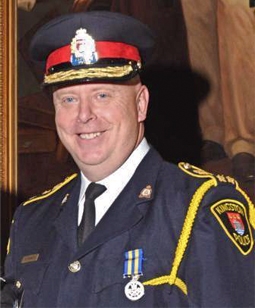 Local boy leaves home; does well and returns to become the new sheriff. Gets a new uniform and a car with a siren. Steve Tanner is the new Halton Regional Service chief of police. Chief Designate Tanner has an extensive record of leadership as Chief of Police in Kingston since November 2008, and Belleville Chief from January 2002 to November 2008. Steve Tanner is no stranger to the Halton Region; he was born and raised in Oakville.
Following his Bachelor of Arts degree in 1982 (Science & Psychology) from the University of Guelph, Steve Tanner joined the Halton Regional Police Service as a Constable in Burlington.
Over his formative 16 years with Halton Police, his career progressed through a variety of operational and supervisory responsibilities leading to his promotion to Acting Staff Sergeant prior to his selection as the Deputy Chief of Police of the Guelph Police Service. In March 2000, he was selected as Deputy Chief for the Belleville Police Service and in January 2002 he was appointed as their Chief. In November 2008 he was appointed as Chief of Police of the Kingston Police Service.
The Burlington that Steve Tanner left in 1998 isn’t all that different to what he is coming back to – his pay cheque will be the biggest change for him
The Halton Regional Police Services Board is the governing body for the Halton Regional Police Service and is comprised of seven members. The provincial appointees are: Bob Maich, Board Chair; Andrew Tyrrell, and Marion Yee; Randy Hammell, Vice-Chair, a citizen appointee made by Regional Council; Mayor Rob Burton, Regional Councillor and Mayor of Oakville; Rick Craven, Regional and Burlington Councillor; and Jeff Knoll, Regional and Oakville Councillor. Oversight and financial accountability for the police service rests with the citizen based Police Services Board.

 REVISED REVISED
By Pepper Parr
BURLINGTON, ON June 29, 2012 It was pretty close to the best community engagement meeting this city has seen since hundreds of us gathered at the Mainway Arena December 2010 to let the province know we didn’t like what they had in the way of plans for the Escarpment.
The meeting at the Arts Centre last night was a little more limited in its scope but no less important for the near term and long term growth of the city.
The meeting had 70 people in the room, working over ten foot long sheets of paper with a detailed picture of the waterfront from the western edge of Spencer Smith Park to the canal that defines our border with Hamilton.
The waterfront on the Hamilton side of the canal is robust, busy; used by people and a fun place to be. The Burlington side of the Beachway is a little on the desolate side with very little activity.
The young people get out there at night and howl with too much alcohol in their systems as they roam on the sands along the beach. It is far from a safe place late at night many evenings.
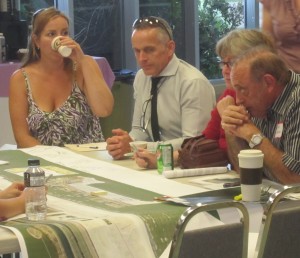 Waterfront Advisory Committee chair Nick Leblovic debates with others during the Beachway Design Workshop. The Waterfront Committee is expected to put forward some views in the fall. While the property belongs to the Conservation Authority, except for the close to 30 homes dotted through the stretch of land, it is managed as a park by the city. It isn’t a park with anything in the way of program. There is a concession stand that is open in the summer; there are washrooms the Regional Health department might want to have a look at some day.
The Pump House is there waiting for a new life and the Water Sewage Treatment plant on the north side of Lakeshore Road – undergoes a significant upgrade and some expansion. The plans the Region has to shield the sewage treatment plant behind rows of trees when the construction work is done will improve the streetscape considerably.
But what is going to be in a part of the city that is now a kind of nature preserve, home to what the Region has referred to as a “dynamic beach” by which they mean sands that are constantly shifting and the base for some very significant flora.
It is not a people place right now. It has a rag tag bit of a community made up of people who see the location as their home with a couple of speculators amongst them expecting to make a killing once development is allowed.
And that of course is the 800 pound gorilla of a word that sits there waiting for everyone to decide what to do with it.
Don’t expect to ever see anything that even hints of the word “new structure” south of the old railway embankment. That is just not going to happen. This isn’t Florida. There is a small park, the Pump House will at some point get put to good public use, the Concession stand will be brought into the 21st century.
But there is more than that happening along the Beachway. The Joseph Brant Memorial Hospital is re-orienting their site and will look out over the lake in a way they haven’t in the past. A clutch of buildings that size will have a significant impact on the Beachway. We don’t know yet what that impact is going to be – but there will be an impact.
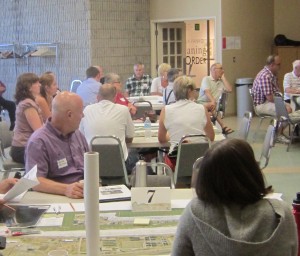 Six to eight people gathered around each table and marked up maps and exchanged ideas with others. All the ideas and the data will get pulled into a report that will eventually get to city council and the Regional government. Ward 2 Councillor Marianne Mead Ward wants to see “eyes on the street” which we take to mean she would like to see it as a place where people live and perhaps even work.
Ward 1 Councillor Rick Craven hasn’t revealed a position yet. He did say, in a jocular tone, that he thought the Pump House would make an excellent official residence for the Ward Councillor. The city needs quite a bit more in terms of leadership from the Councillor on this one.
Meed Ward takes the view that as a city Councillor she represents the direct interests of her constituents but sees herself as perfectly free to talk about ideas for any part of the city. That approach doesn’t sit well with Craven – but as this council now knows – there is no stopping Meed Ward. This is a bigger picture politician.
The Waterfront Advisory committee has decided it will lead from behind and is waiting to see what the report from last night’s meeting has to say. They expect to have something to say in the fall.
The Manager of Council Committees services, Grant Bivol, has completed the first draft of his report on the effectiveness of the Waterfront committee. The report has come back to Bivol for some revision and will get sent to council committee soon. Waterfront Advisory may not be around to offer any advice come the fall. And that would be regrettable. The city needs a citizens committee to offer advice; the one in place now will probably not exist at the end of the year.
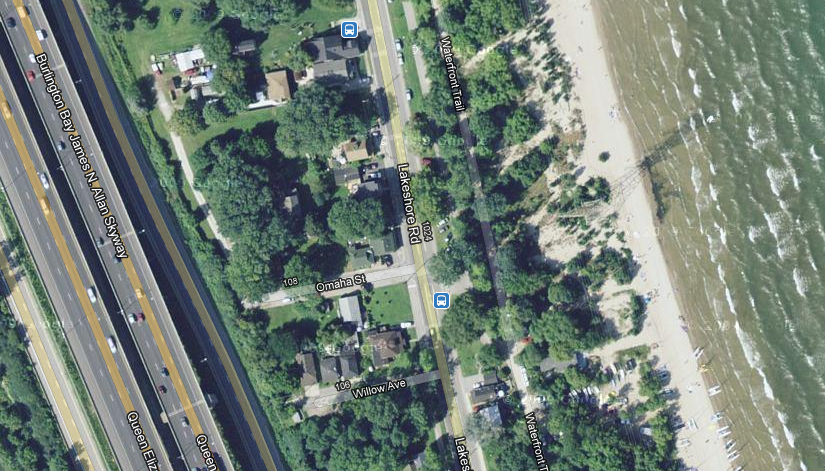 These homes between the Lakeshore Road and the QEW are privately owned. Is there a future for this very small enclave. Some home owners have invested significantly to improve their property. Other buildings are left to languish. The community needs some leadership, if not from the Ward Councillor then from city council. There is room for some development in the Omaha and Willow Streets part of the Beachway. This would be a great part of the city for an arts community; a quiet enclave where artisans could do their work. Small consulting firms would fit into this kind of environment as well.
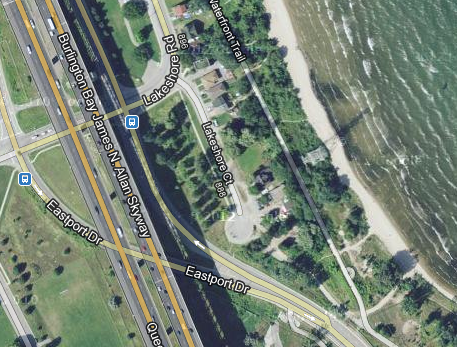 Many of these homes back onto the old railway embankment – now known as the Waterfront Trail. Is there a future for these homes? Has either the city, the Region or the Conservation Authority made a point of listening to the view of these property owners? Have the property owners managed to make their case and delegate to the levels of government that determine what their property future might look like? And what can be done with the houses that are on the south side of Lakeshore that back into the railway embankment?
The walking path has become the back yard for some of the houses along there; they are basically encroaching on public property.
The Thursday evening meeting was the third in a series that started with an event at the Waterfront Hotel where the home owners were out in force telling their story and getting very emotional in the process. The second took place in Milton where maybe two people from the Milton community showed up.
Each of the ten tables set up on Thursday, had all the tools you needed to mark up the maps, write in comments, draw lines and argue a point of view. There was a facilitator at each table taking notes that will get pulled together into a document the region will then use to prepare a draft recommendation that will go to the Regional Standing Committee that handles parks related matters and to all the municipalities.
The Conservation Authority will get involved – they do own the land that is not in private hands.
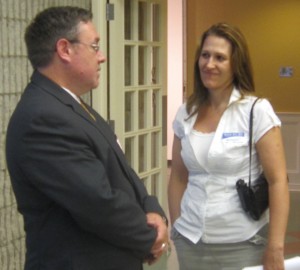 Senior Regional Planner Stirling Todd talks with Ward 2 Councillor Marianne Meed Ward – each has their own agenda when it comes to the Master Plan for the Beachway. During the past year and a half, the Region has had their Senior Planner, Stirling Todd, attending Burlington’s Waterfront Advisory and Access Committee. On numerous occasions Todd has spoken of the dynamic beach and the threats it faces with the moving of sand. This, along with flooding potential, was mentioned almost every time Todd spoke. The Waterfront people and the Conservation Authority as well as the community in the Beachway, wanted to know if the dynamic beach had in fact shifted – and it had, further out and not further in as Todd has consistently claimed.
Serious flooding during a 1970 storm got upgraded to a threat that made the whole area very unsafe were water to come roaring in over the railway embankment. The community was told that the water would pool on the north side of the embankment and be a serious public hazard.
The Water Treatment plant lies in this same area but there is never any mention of the flooding impacting on that plant. Imagine the mess if the sewage treatment plant was taken out of commission because of a flood? Flooding is never mentioned when people talk of the Joseph Brant Memorial Hospital which is in that part of the Beachway. The hospital is reported to be in the lowest part of the flood plain but that hasn’t stopped them from rushing forward with plans to have shovels in the ground by the end of the year putting up a significant addition to the hospital.
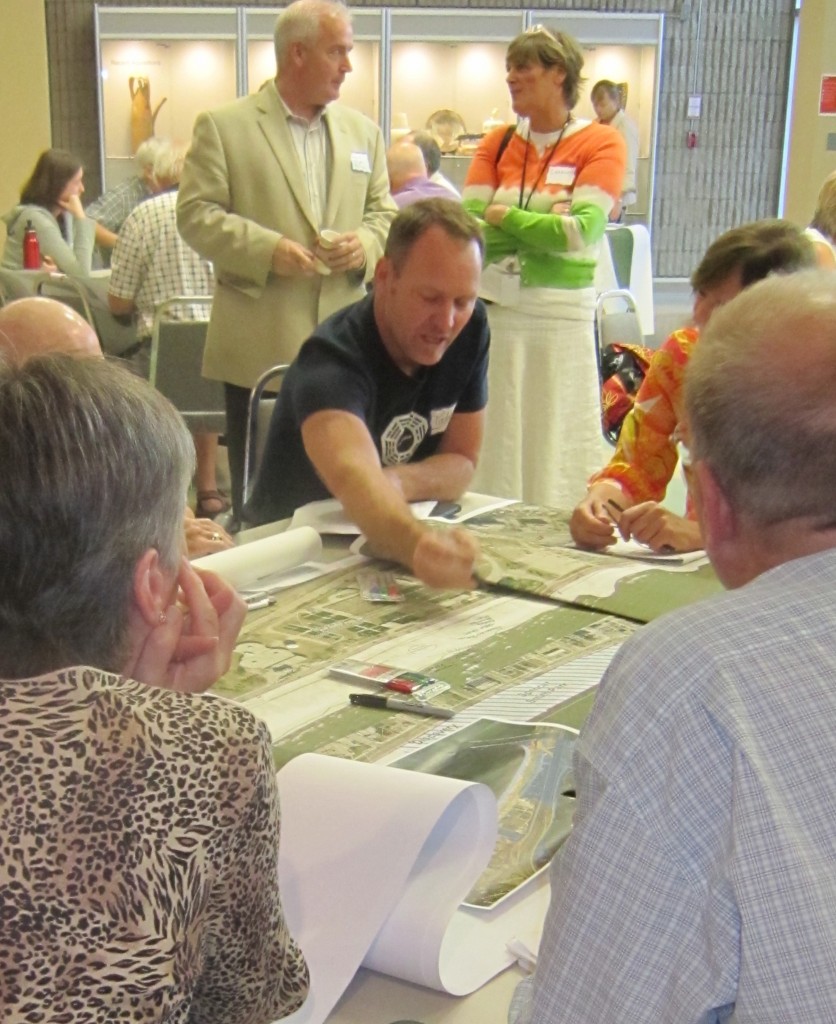 People gathered at the more than 12 tables at the Arts Centre and worked through what they would like to see done in terms of a design for the Beachway Park. The facilitator never used the word community to describe the area that holds 30 homes. City General Manager Community Services Scott Stewart looked in on the conversations. One gets the impression that the Region’s Senior Planner was being somewhat disingenuous with the people in the area that own property and using the dynamic beach and the flooding possibilities to scare the local residents who just want their community to remain.
The Region and the Conservation Authority do have an agenda; they just haven’t shown their hand yet.
The Workshop was led by a very able facilitator who used different language Thursday evening as he described the location. Last night he consistently referred to the place as a “park”. That was not a word he used as often during the first two public meetings he facilitated.
While the location is indeed a park, it is also a community and a part of the city that houses the sewage treatment plant and a large marshalling yard for Ministry of Transportation vehicles. Using the word “park” all the time kind of precludes any other possibilities. The Beachway has a rich history as a community; and it is a community today.
Laura and Glen Gillespie, two Beachway residents who are proud home owners were very vocal at the first community meeting. Laura, a bright vivacious woman tends to get emotional when she talks about her home. Both she and her husband can be disruptive and they are very direct. This is where they live and they have the sense that they play no part in what is going to happen to them. Many others in the community feel the same way – but they don’t state their concerns as directly as the Gillespie’s.
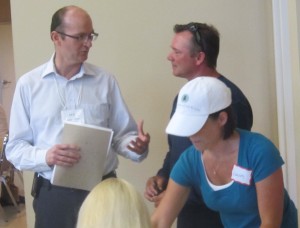 Glen and Laura Gillespie were greeted by the event facilitator when they arrived to register. When they entered the meeting room last night the facilitator was right there beside them, almost like a police officer keeping an eye on a truant – he didn’t want the trouble makers getting out of hand and ruining his meeting.
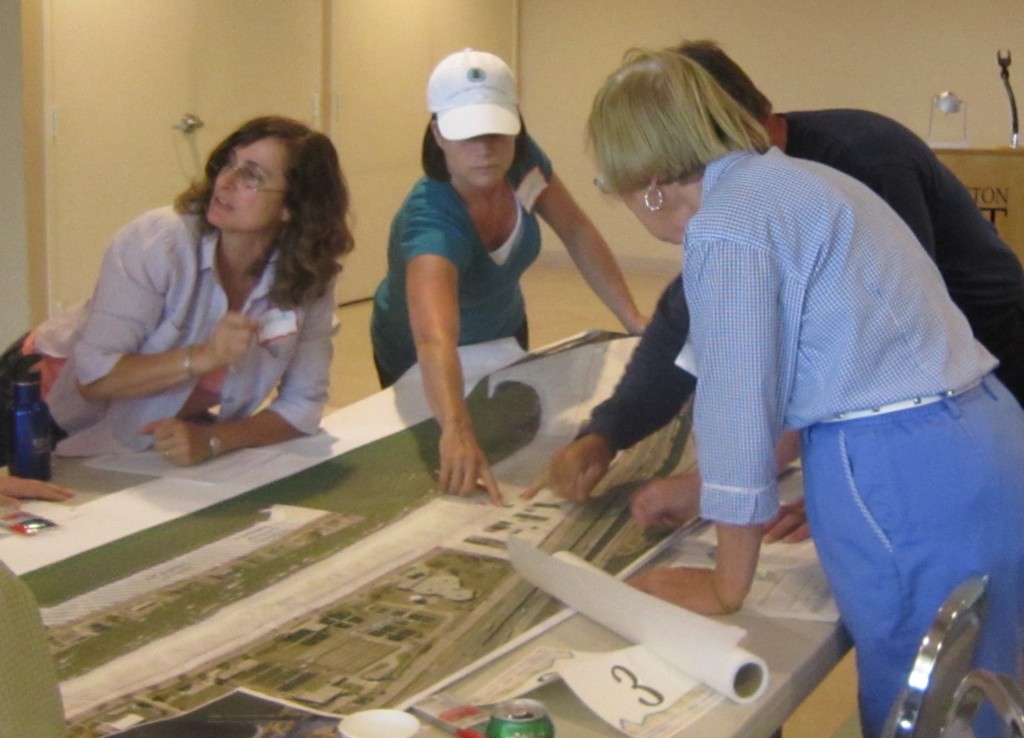 Laura Gillespie points to a part of the Beachway that is important to her and her husband – it’s where her home is located. The Gillespie’s have been very vocal with their views and they speak for much of the Beachway community. The Gillespie’s aren’t trouble makers – they are property owners who want informed answers to their questions. They had hoped to be able to talk with their council member – he chose not to engage them and suggested they make an appointment to meet with him.
The Region has a policy of buying up every piece of property that came on the market but the formula they use for determining the price the Region/Conservation Authority will offer results in private interests buying up the properties. Is there any land assembly taking place – hard to tell but most people don’t think so.
Parking seemed to be the biggest concern. There is bus service into the area.
No one spoke all that passionately about putting the Freeman Station somewhere along the Beachway Park.
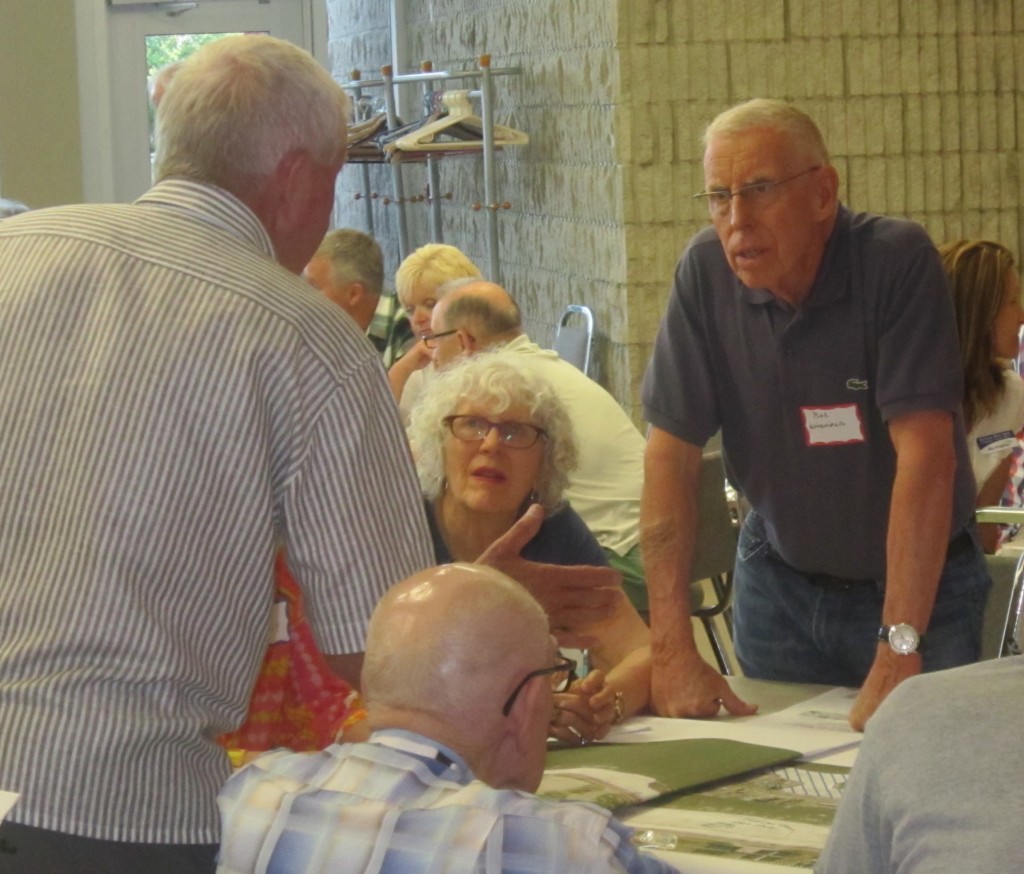 Councillor Jack Dennison and downtown resident and Waterfront Advisory Committee member Bob Wingfield talk through a viewpoint on the Beachway. Bob’s wife looks on. Mark Gordon, a downtown core resident reflected on the meetings that brought Spencer Smith Park into being and said the meeting that focused on the Beachway last night was not much different. Gordon added that it took a long, long time for the citizen involvement to have any impact. Spencer’s at the Waterfront restaurant was supposed to be a “family” restaurant – and it certainly isn’t that today. Families get shuffled off into the lower level where they can buy candy from vending machines or hot dogs and hamburgers from a counter. They are decent hamburgers however and the place is clean.
The Beachway – that magnificent stretch of sand that was once bordered on the north by a CN rail line and was once the location for very close to 300 homes that began as summer cottages and over time got upgraded to year round homes.
Most were on leases from CN Rail. When the Conservation Authority took possession of the rail line and the land, the leases came with the land. When the leases expired they weren’t renewed and one by one the houses were torn down.
Three of the six Burlington council members were in attendance; Meed Ward, Craven and Dennison, those with a significant interest in how that part of the city develops. Mayor Goldring did not attend.
The city has yet to put forward an opinion and the Beachway isn’t a large part of the Official Plan Review. It’s almost as if the Beachway isn’t something the city can do anything about or isn’t ready to come forward with an opinion and offer a sound sense of direction to the Region.
Every member of council will refer to that part of the city as the jewel in the city’s crown – but no one seems to want to polish the jewel and make it something worth showing off and making use of.
There have been plans for the Beachway part of the city right back to the days when the former Mayor of Toronto David Crombie created the Waterfront Trail. There was once going to be A Discovery Centre close to the canal but that went to Hamilton where it failed.
Former Toronto Mayor David Crombie told the Waterfront Advisory Committee when he spoke to them that there was a time when Burlington was a leader in waterfront advocacy but that that was some time ago and is no longer the case today.
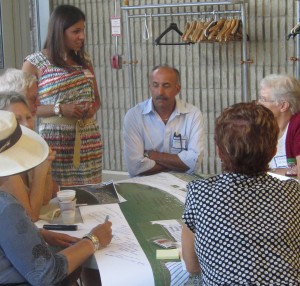 One of the Molinaro boys quietly listening to the conversation on how best to use the Beachway. So – what does Burlington want to do with the Beachway? Spencer Smith Park is well developed, heavily used and a splendid place to spend time – any time of the year.
There is a future for the Beachway as well – but if the citizens have ideas, hopes or aspirations for that part of the city – they need to make their voices heard now, or the Conservation Authority and the Region’s Senior Planner will impose what they think we should have.
Along with the 70 people on the room toiling over maps and fervently discussing their ideas, there was at least one city developer quietly listening.

 By Pepper Parr By Pepper Parr
BURLINGTON, ON June 29, 2012 Halton Regional Police have laid a total of 140 charges related to fraud and identity theft
Early in March 2012, the Regional Fraud Unit began an investigation that focused on a large amount of identity theft and account takeovers within the Halton and Toronto area.
 Thieves see identity theft as easy - they see your identity as money in their pockets. Protect yourself. The targeted group would commit identity thefts and attend financial institutions and get access a victims bank using identity they had stolen and then removing funds from an account.
The project culminated on June 27th with the arrest of three individuals and residential search warrants executed in both Milton and Toronto. Police recovered an assortment of identity documents, false identifications, credit cards, computers, instruments of forgery and cash.
Police are in the process of contacting the victims of these identity thefts and the investigation is ongoing as police anticipate laying additional charges.
Charged are Christopher Corey DEWSBURY (31) and Camille DEWSBURY (30) of Milton and Shelley Marie BOIS (53) of Toronto.
The trio face over 140 criminal code charges relating to Fraud, Possession of Counterfeit Mark, Possession of Identity Information and Conspiracy to Commit an Indictable Offence. All are scheduled to appear in Milton Court on the 24th of July, 2012.
Anyone with information concerning this or any other crime is asked to call Crime Stoppers at 1 800 222-TIPS(8477), through the web at www.haltoncrimestoppers.com or by texting “Tip201” with your message to 274637(crimes).

 By Staff By Staff
BURLINGTON, ON – June 28, 2012 Tickets for the Jane Goodall presentation are now available at the Performing Arts Centre box office. VIP tickets are priced at $125. Main Event tickets are $45 – add HST to those prices.
 Jane Goodall will be in Burlington September 19th speaking at BPAC. Chimp is not expected to attend. Acclaimed primatologist , environmentalist and United Nations Messenger of Peace, Goodall will entertain with of stories from the field, her reflections on global conservation and hope for the future of the planet.
The VIP tickets include a cocktail reception and an opportunity to interact with Goodall personally. This is a woman who took on the establishment and insisted that primates be protected and studied and did so at considerable personal risk. While she is lauded and applauded today there was a time when the world didn’t have much time for Jane Goodall.
She is one of those people who lived her personal convictions and brought the world to a point where it saw the environment in a different light. She made a difference.
During the Main Event Dr. Goodall will take questions from the audience. She is both an amusing and at the same time a very forthright speaker; there is seldom any doubt as to what Jane Goodall thinks.
BurlingtonGreen has stretched this event and added a level of community involvement, for which they should be applauded. The evening is going to include the recognition of six “eco-award” winners who will be chosen by the community.
Burlington citizens, schools, groups and businesses are being asked to submit nominations before August 27, 2012 highlighting their greening efforts. BurlingtonGreen president Ken Woodruff explains that “recognizing the positive contributions of our community in helping the planet locally is very important as it inspires others to get involved and take action as well.”
Details are available at: burlingtongreen.org for event and ticket information and to complete a nomination form for a local eco-hero.
The Burlington Community Foundation and the TD Friends of the Environment Foundation have provided early level sponsorship for this event. Additional sponsorship opportunities are available to support the event. Contact info@burlingtongreen.org or 905-466-2171

 REVISED June 29; 8:25 am REVISED June 29; 8:25 am
By Pepper Parr
BURLINGTON, ON June 28, 2012 The Halton Regional Police Service has a new chief. The Police Services Board made their decision this morning and will announce their choice on Friday.
To use police language, the announcement has to wait until the next of kin has been advised, which means the new chief has to advise the police service he is presently with, that he is on his way out.
We do know this:
 A new uniform with the Halton Regional Police Service crest sewn on the shoulder will be made up soon for the new police chief to be announced Friday morning. The choice is not current Deputy Chiefs Bob Percy nor is it Deputy Chief Andrew Fletcher. Both are believed to have been in the running but the Board decided to bring in someone from outside the Halton Police Service.
However, the person being brought in is believed to have served with the Halton Police Service at some time in the past.
The Board used a firm of head hunters that had extensive experience with municipal and police force hires.
We know that the choice comes from a large reasonably local police service and that the name is one that will not surprise many people.
Former police chief Gary Crowley advised the Board WHEN that he wanted to retire. Health issues had him operating at less than full capacity and while Crowley was well served by two seasoned deputy’s it was time for the Region to look for a new chief.

 By Pepper Parr By Pepper Parr
BURLINGTON, ON June 28, 2012 Friday’s from 11 – 2
Starting tomorrow, June 29th – the Plan B Organic Farm will open at the Centre Market – on Brant Street across from city hall and a dozen or so steps up the street. The group is made up of a handful of exuberant local natural food vendors. The theme is: small, local, natural food market.
 Pork from Featherstone Farms will be available at Centro Market - this Friday 11-2 Featherstone Farmers from Lowville will be joining Centro Market with their local farm raised Heritage Pork and natural goats milk soaps.
The vendors list will grow – what is firm is the time and the location: every Friday – 11- 2
Both the city and Brant Street have been waiting for something like this.
The Centro Market focuses on directly connecting local growers and makers of natural and organic foods to people in their community — to share a healthy lifestyle.
If you’re a possible vendor shoot an email to: communications@centrogarden.com

|
|































































































